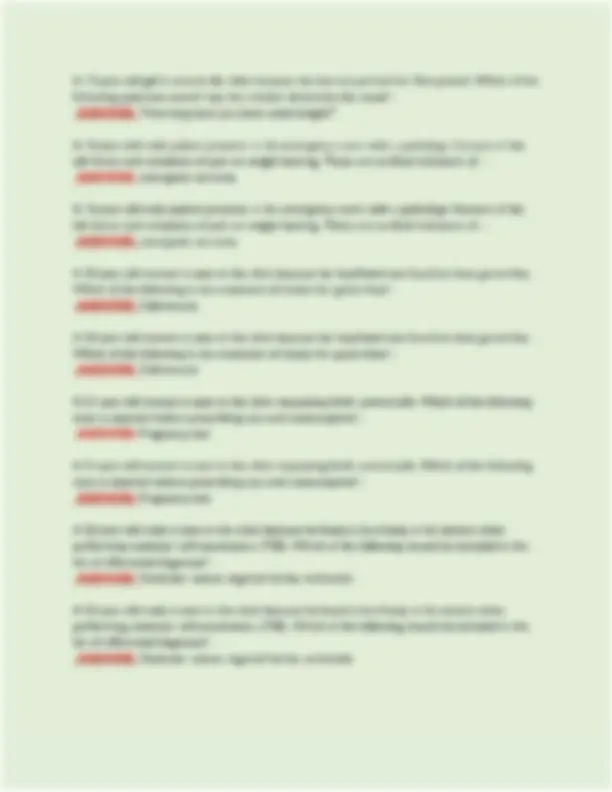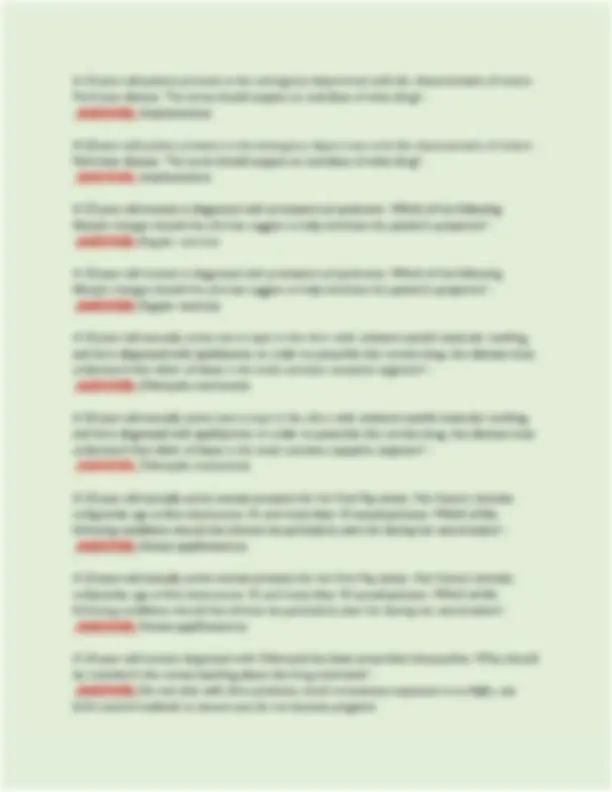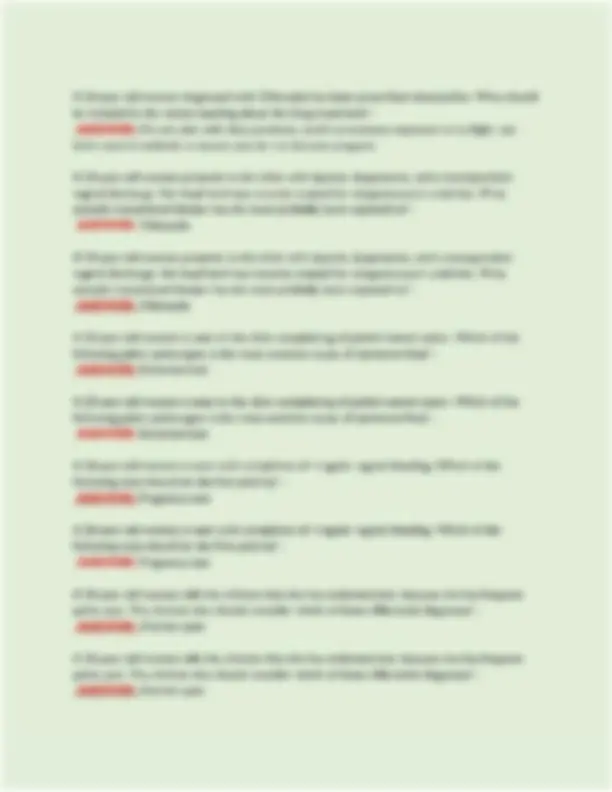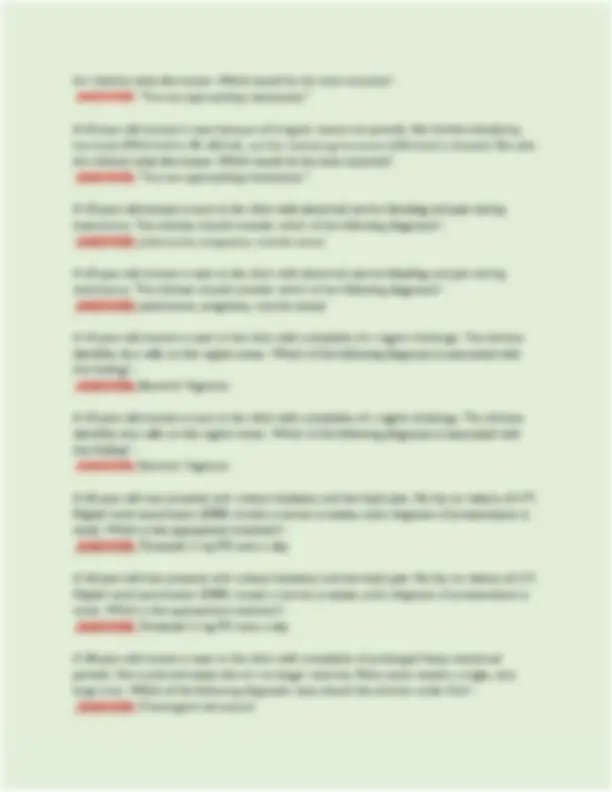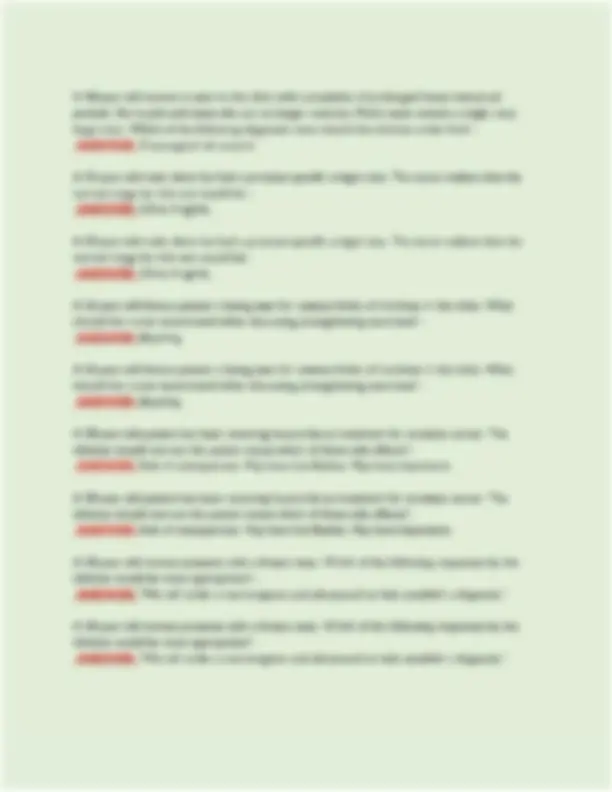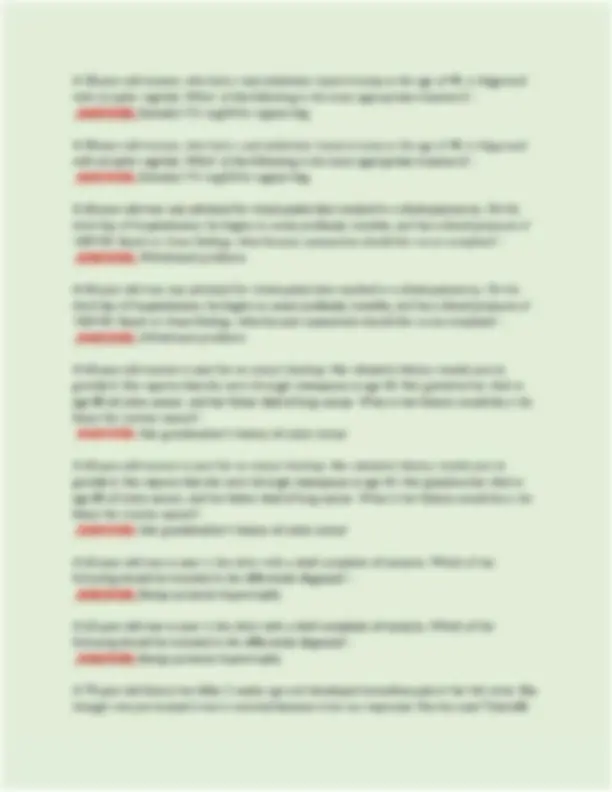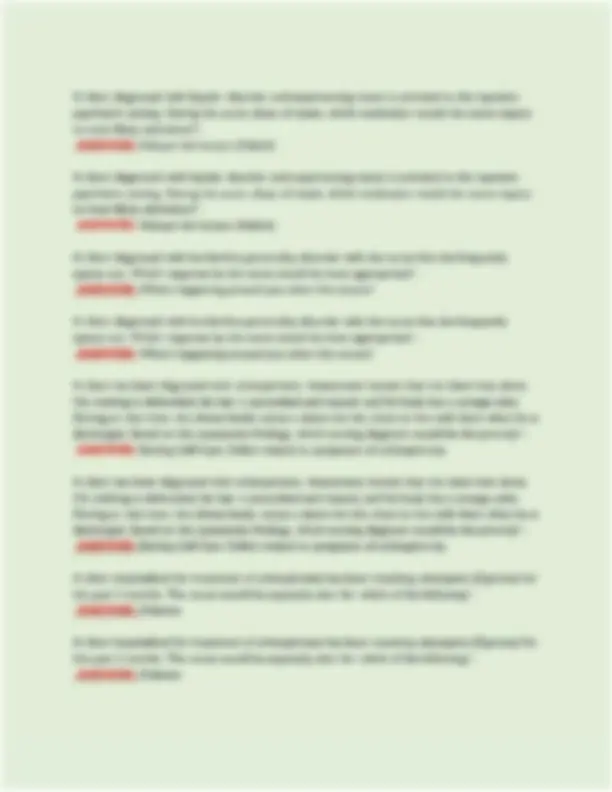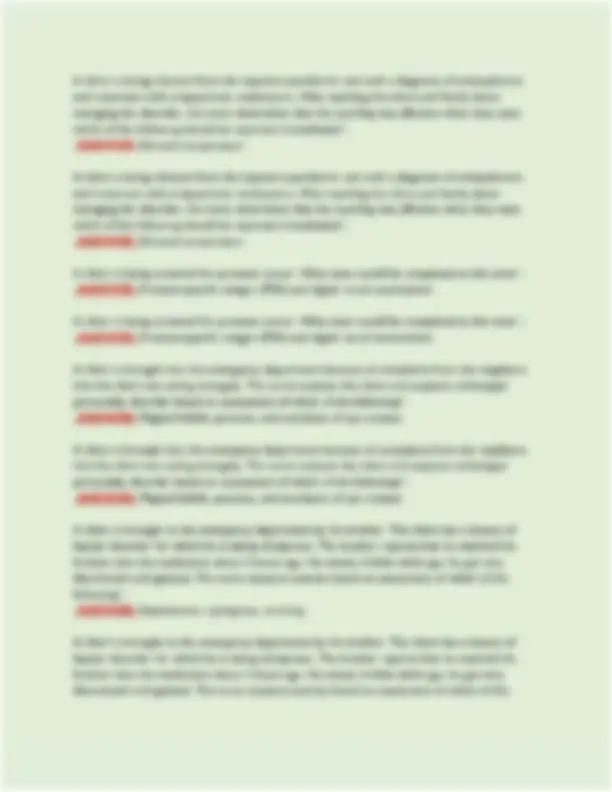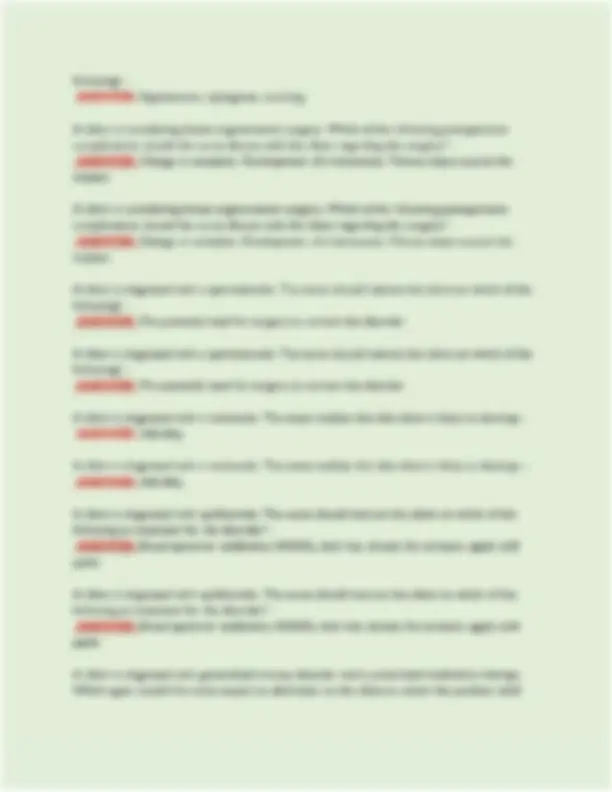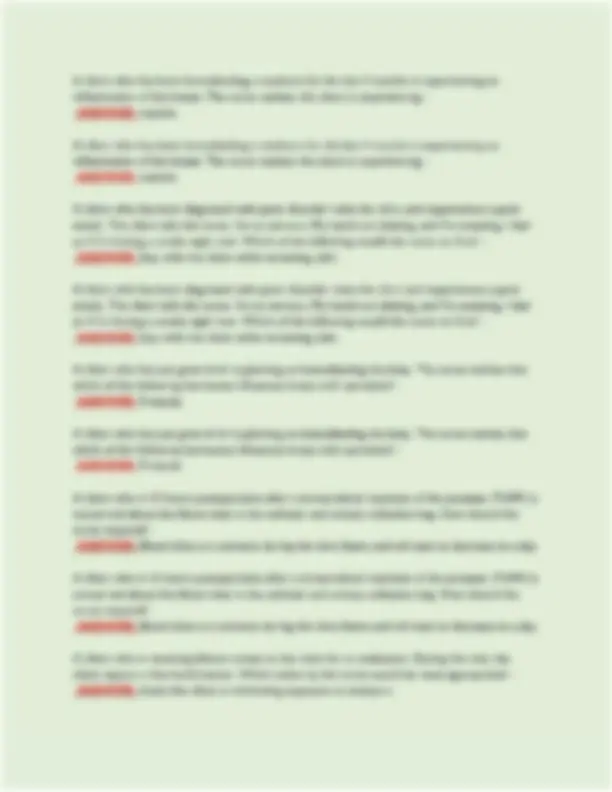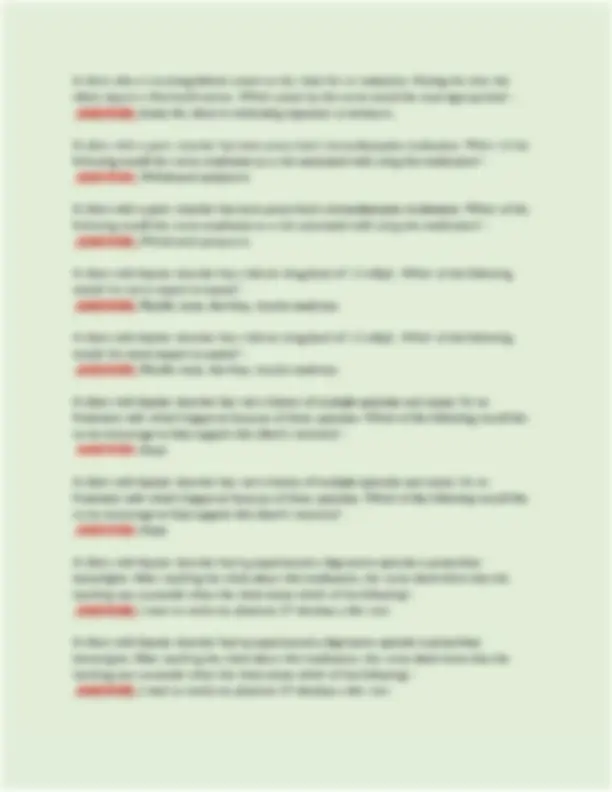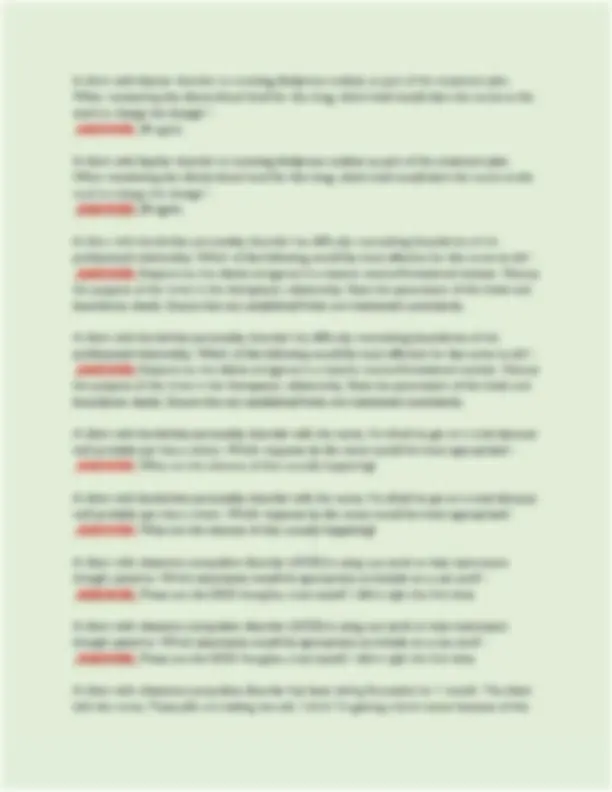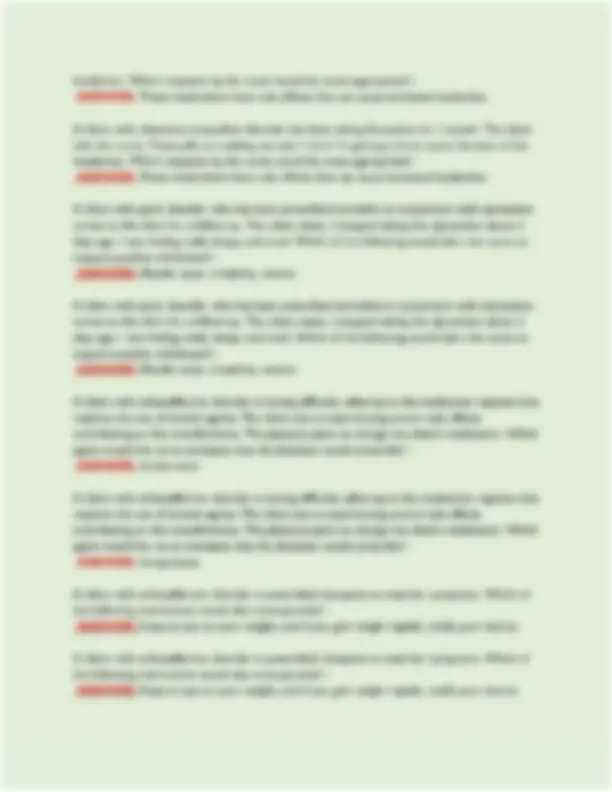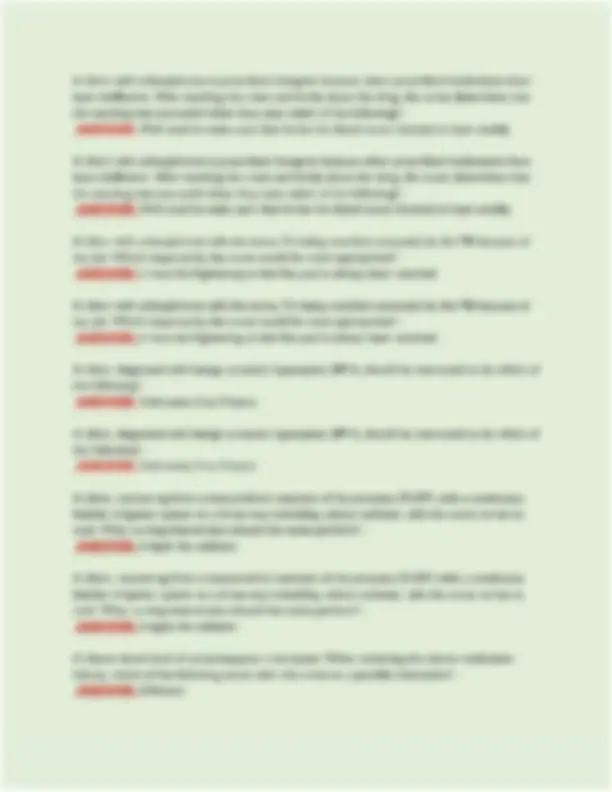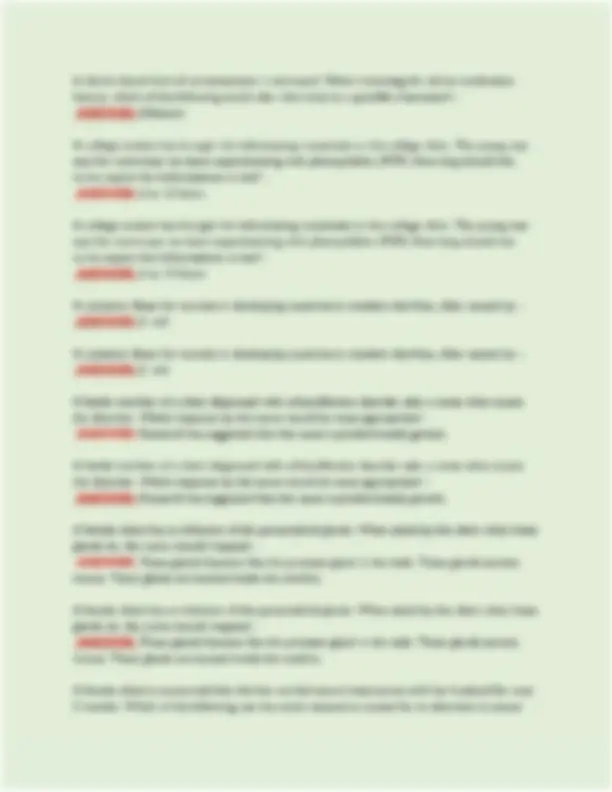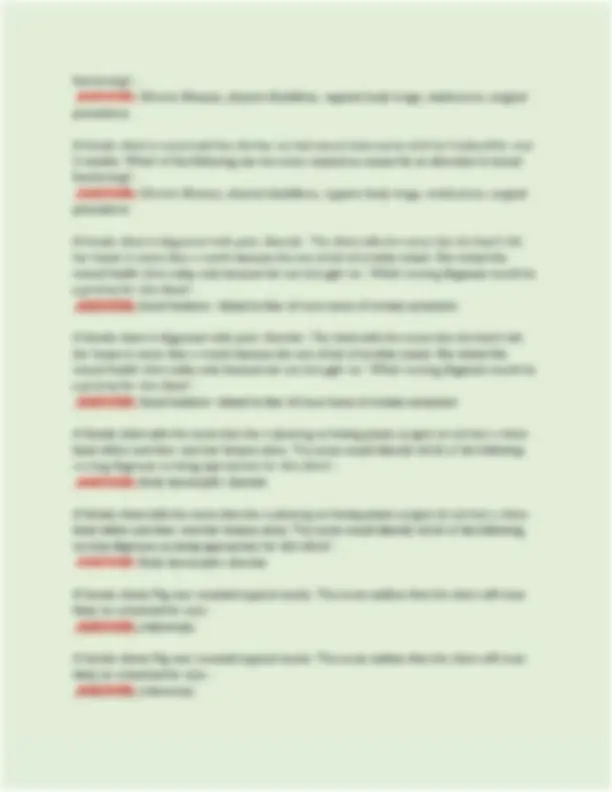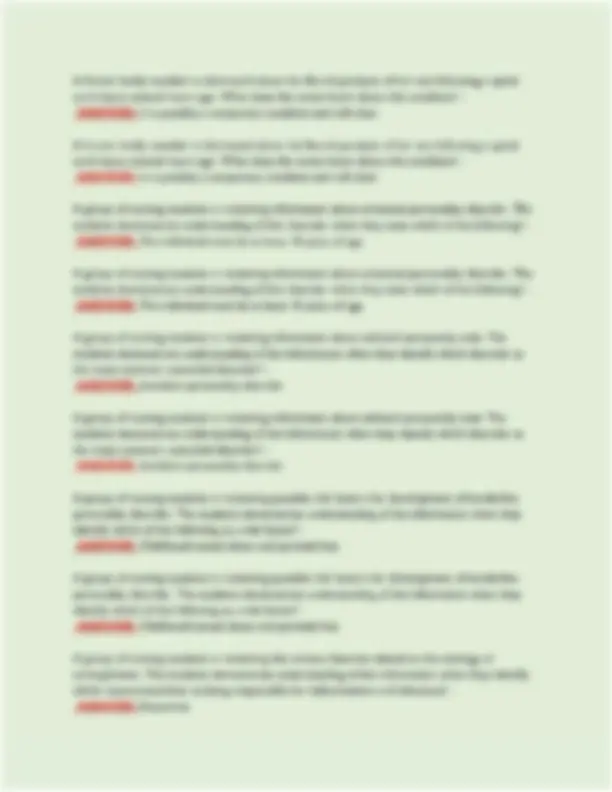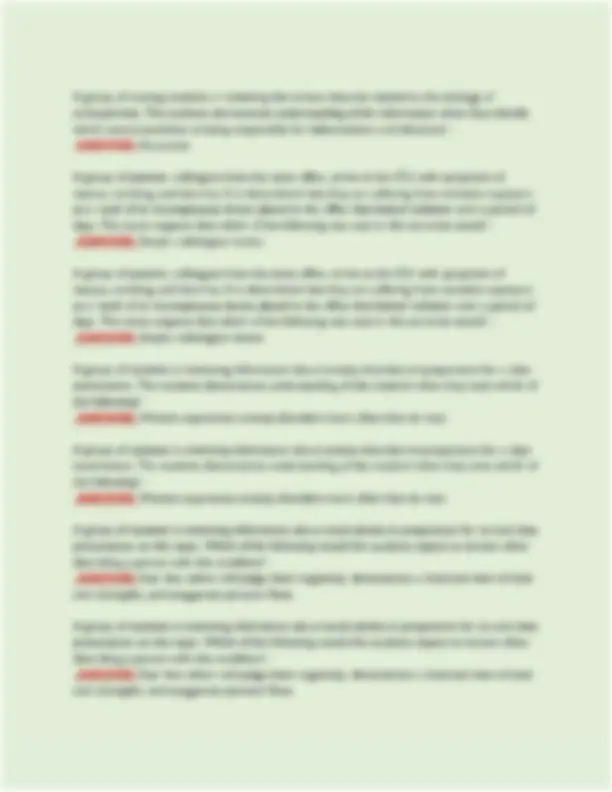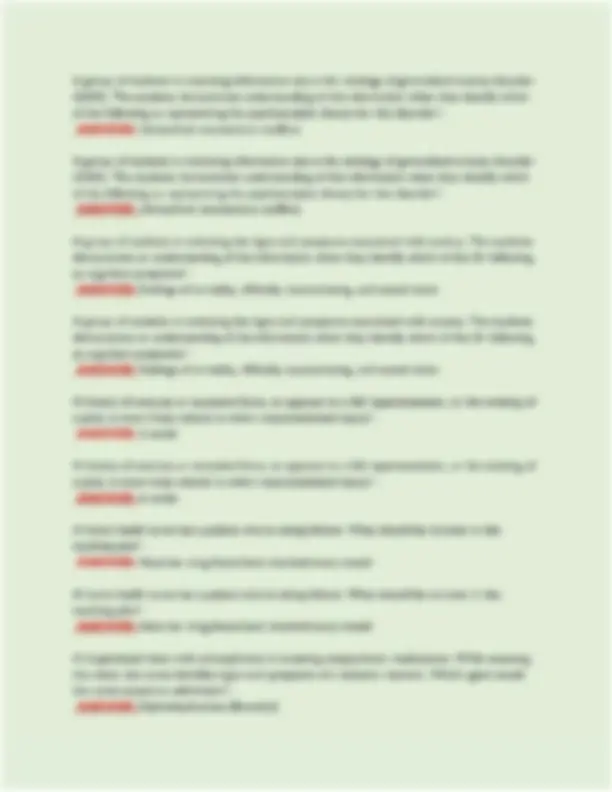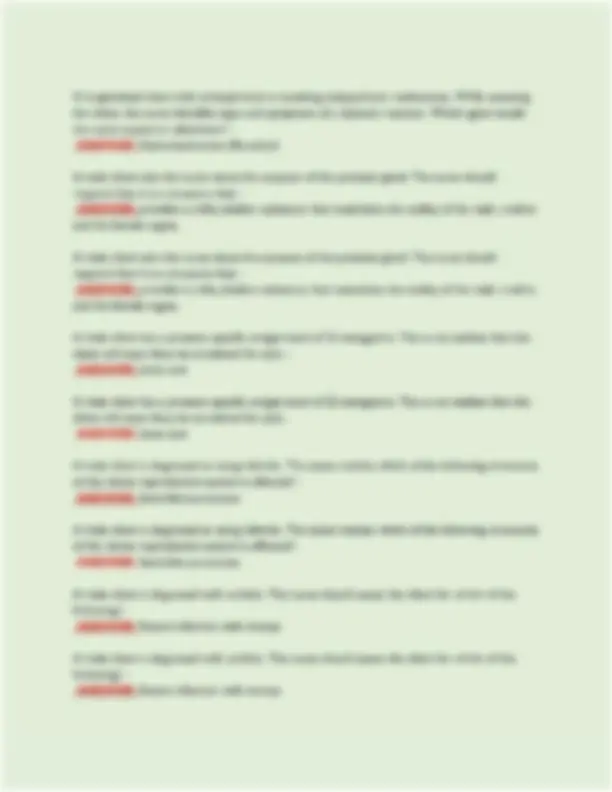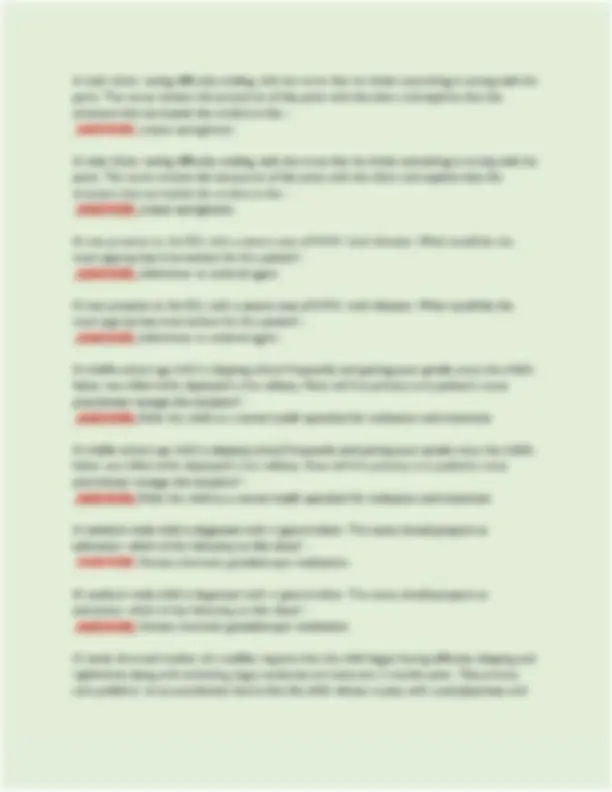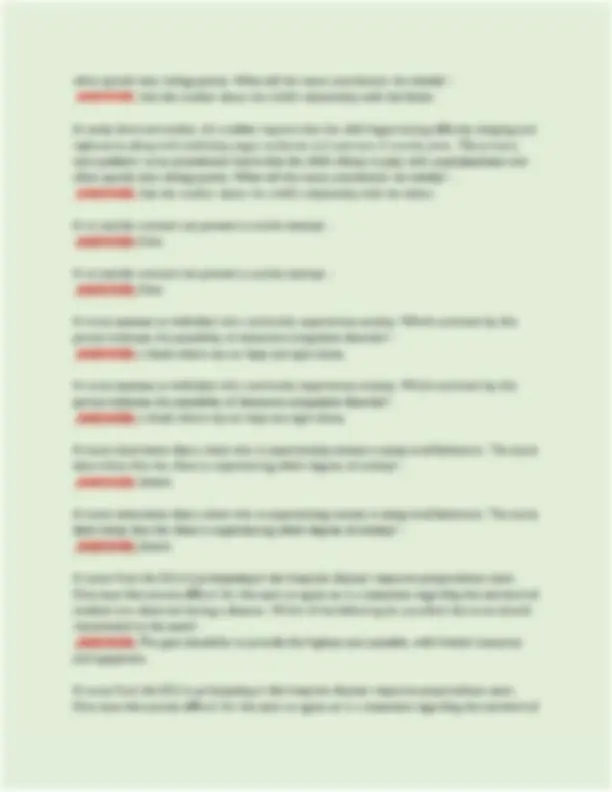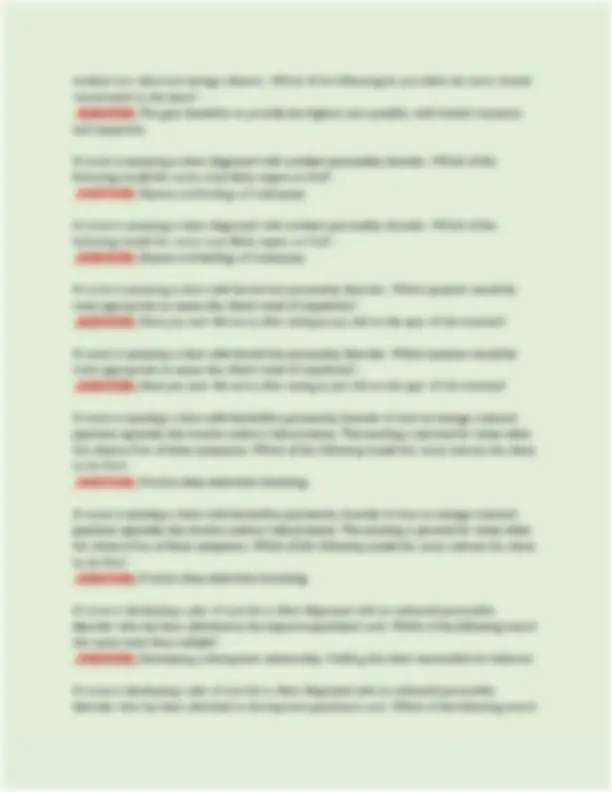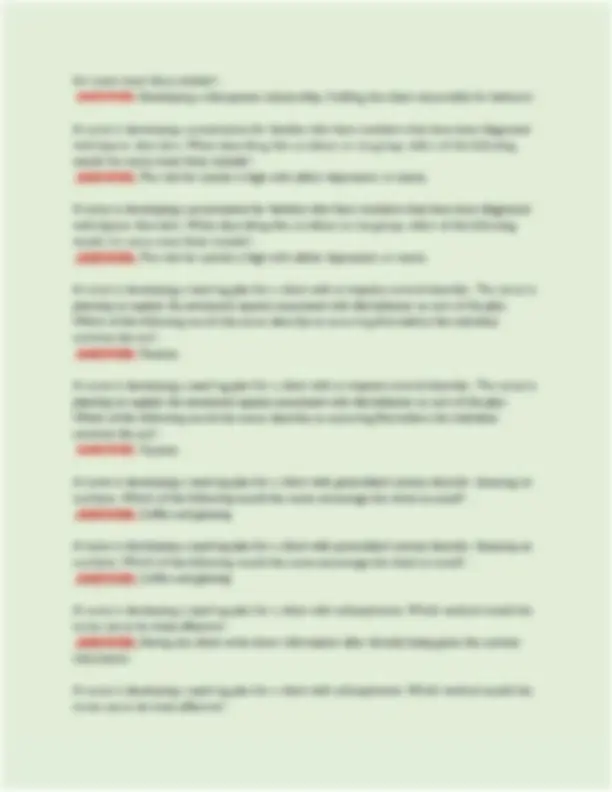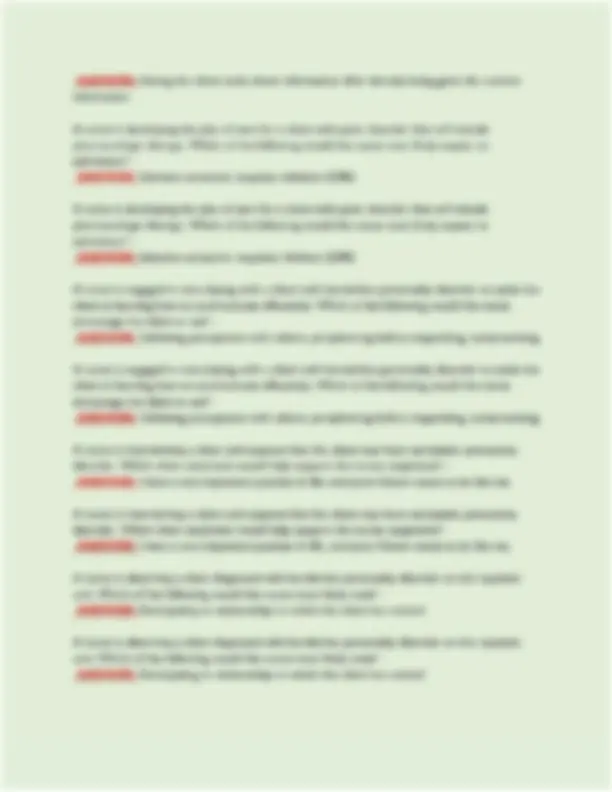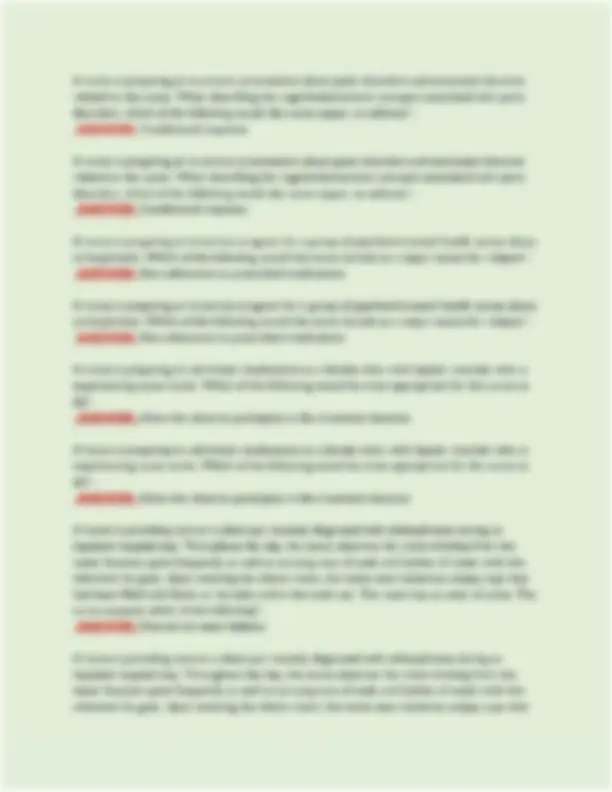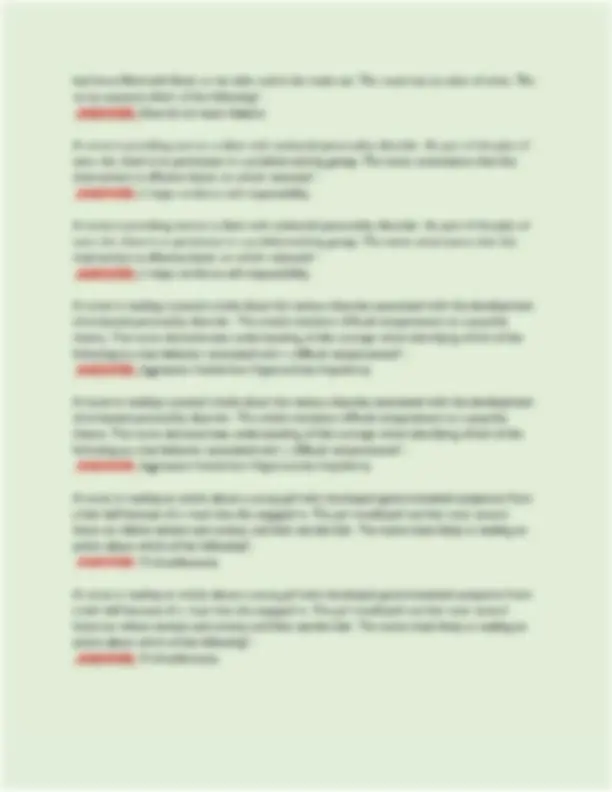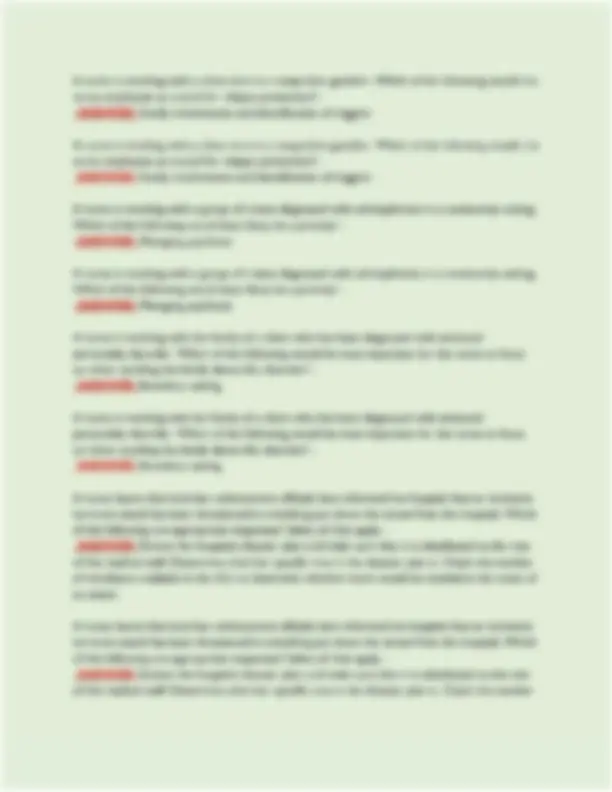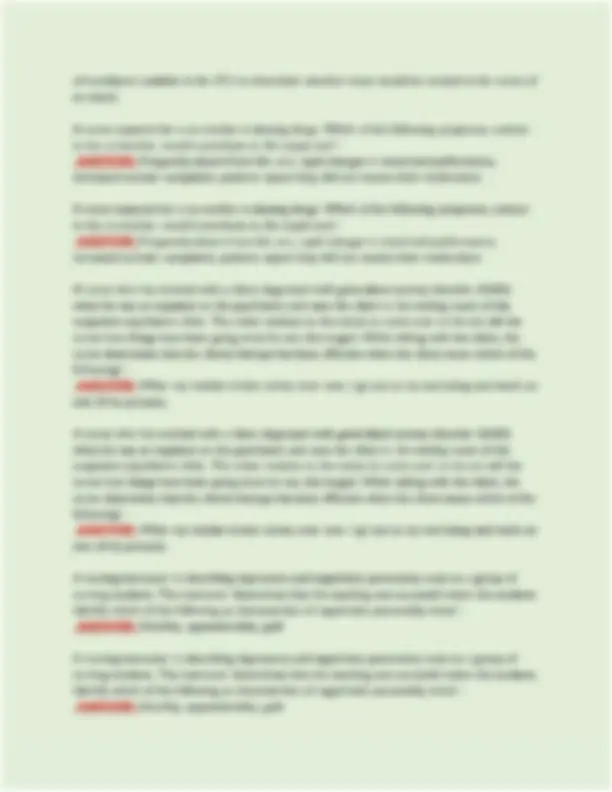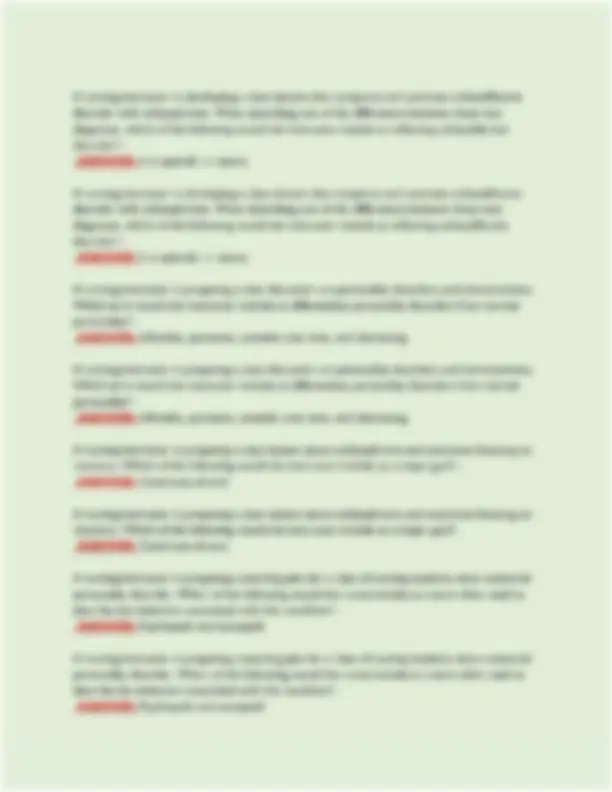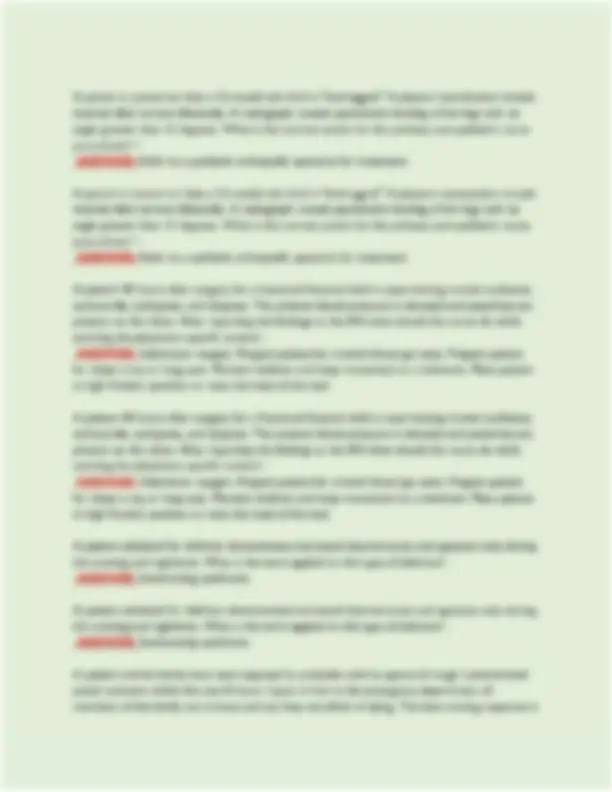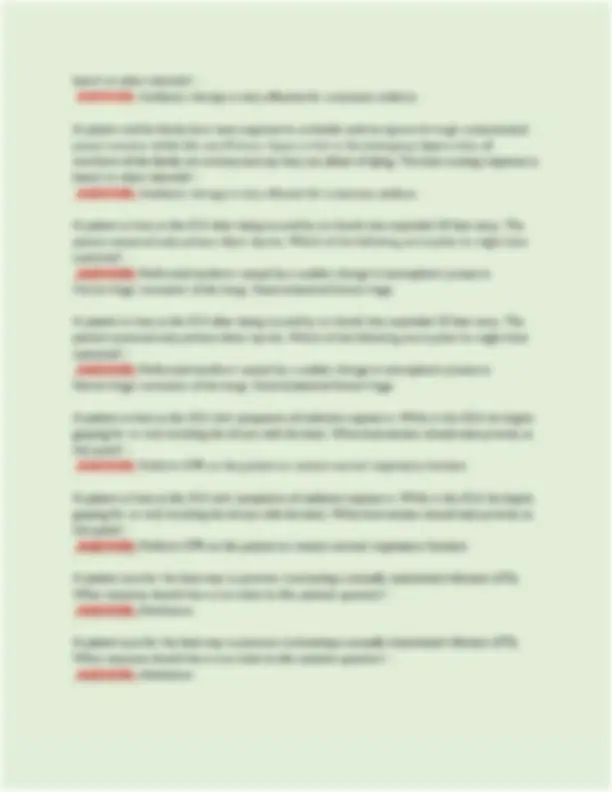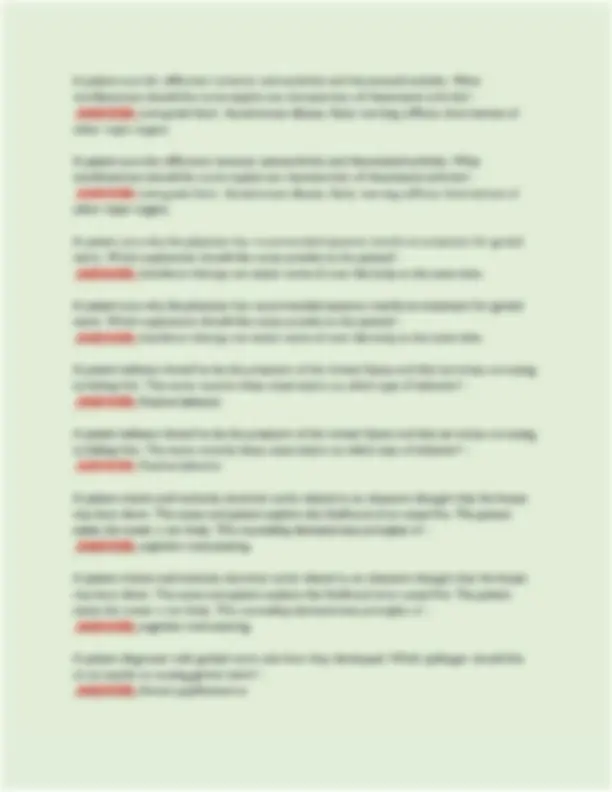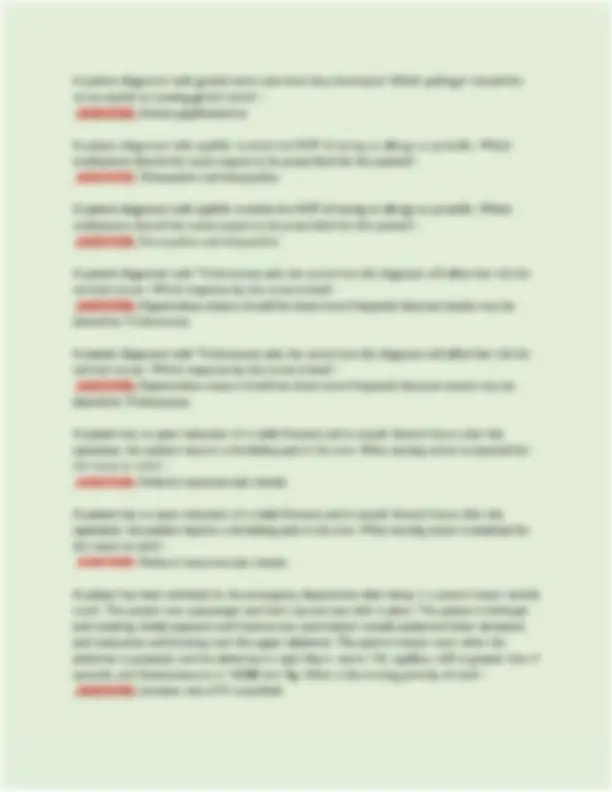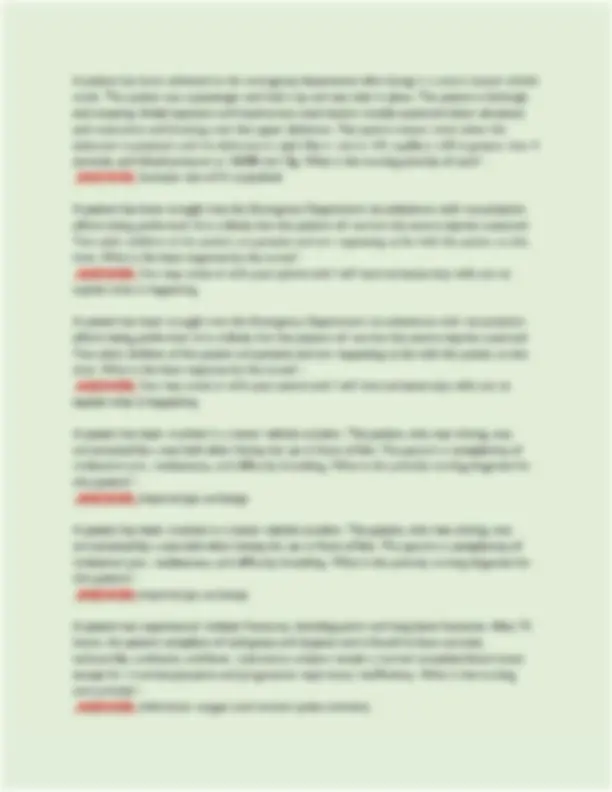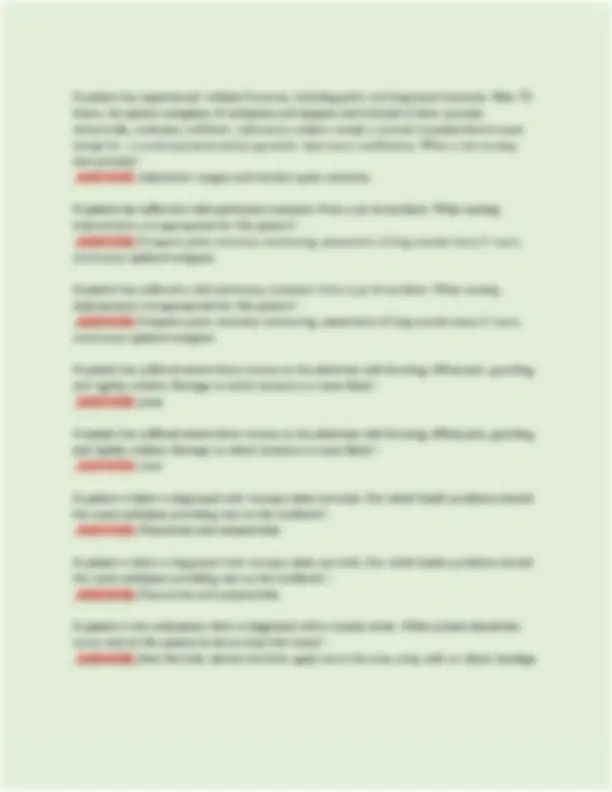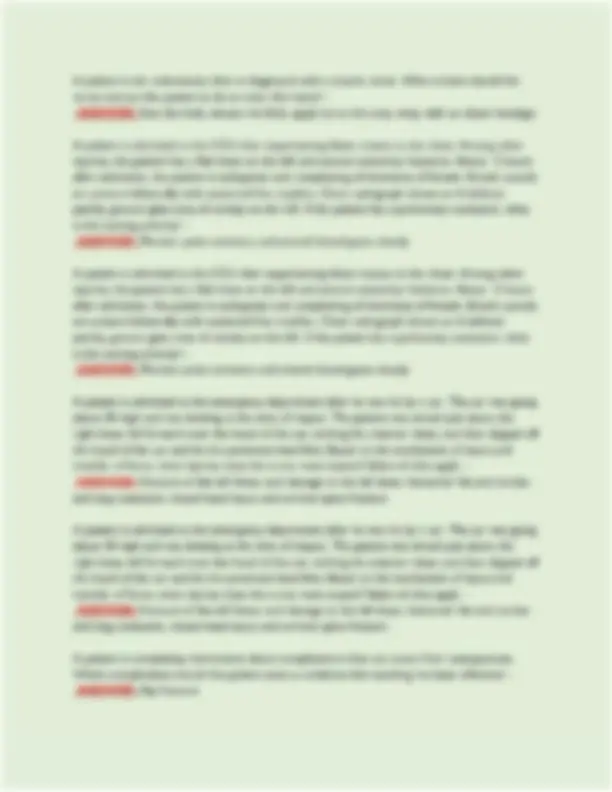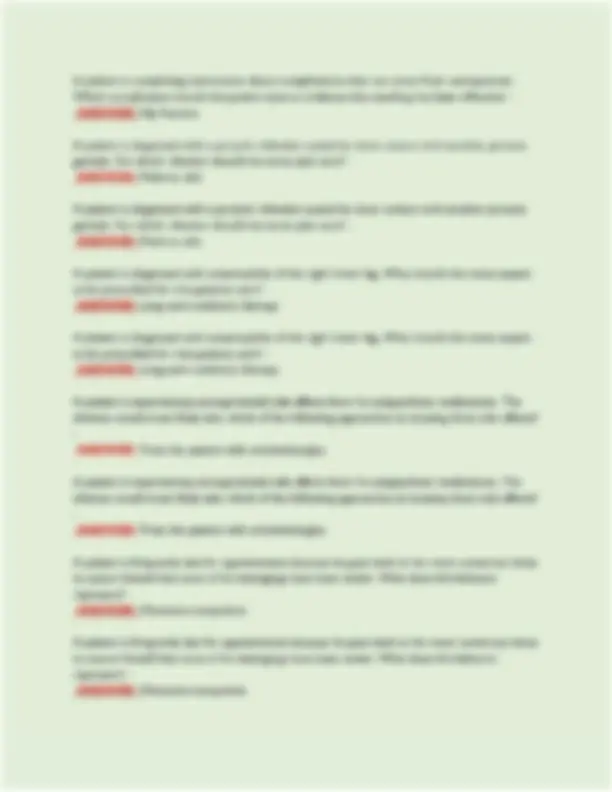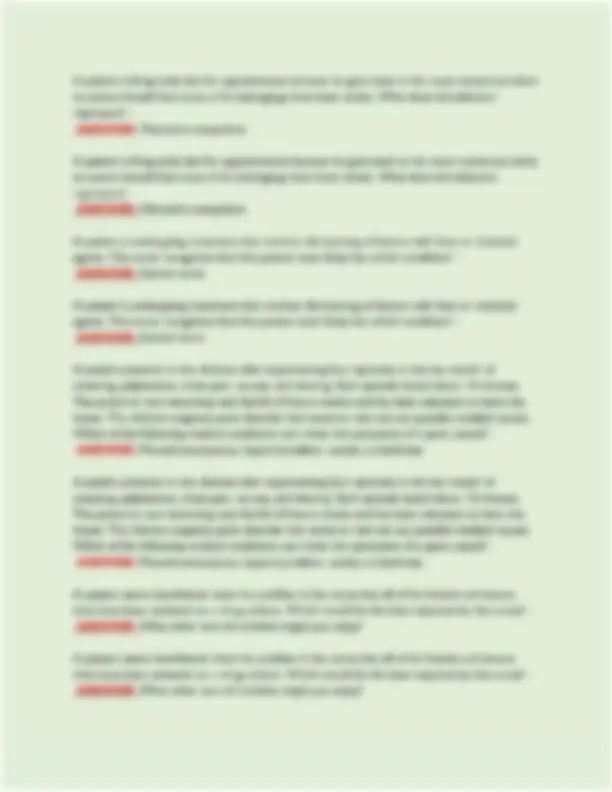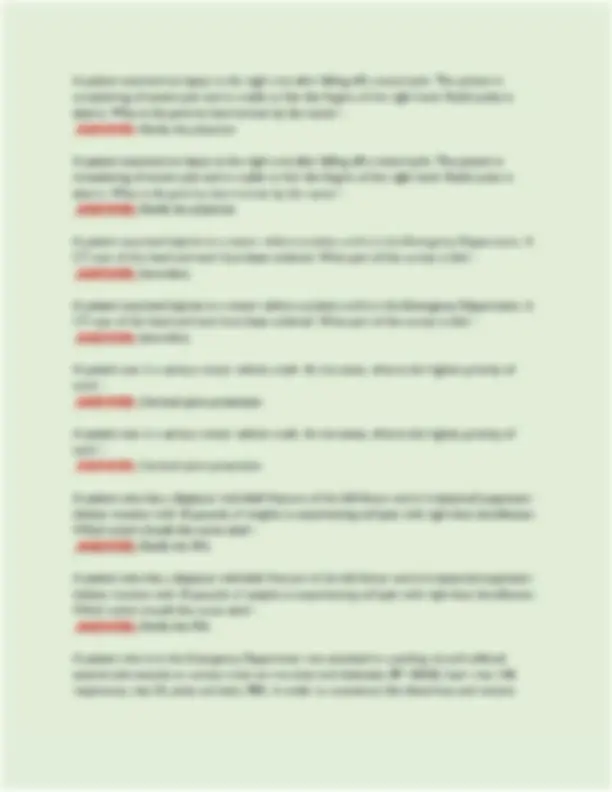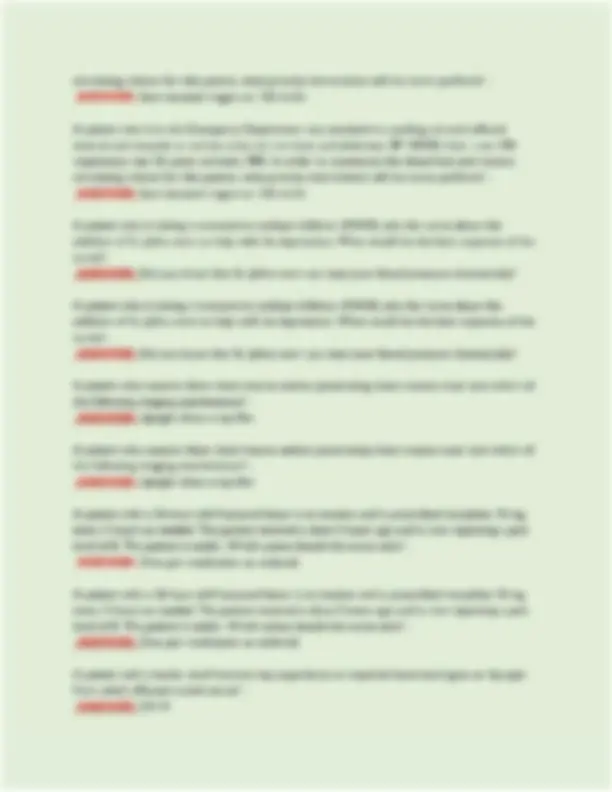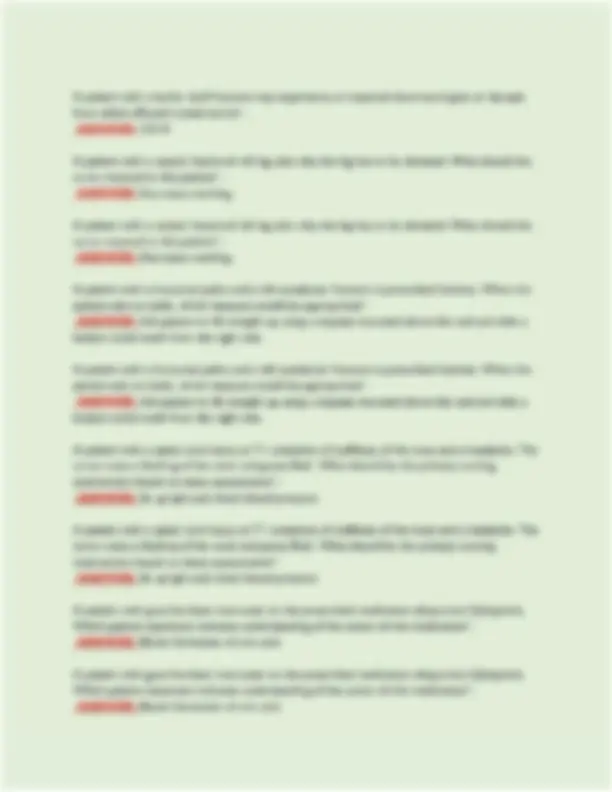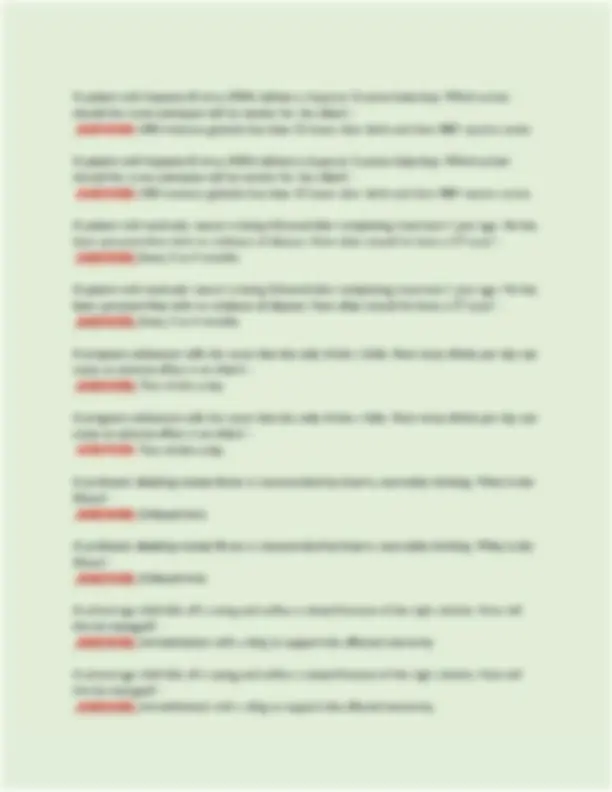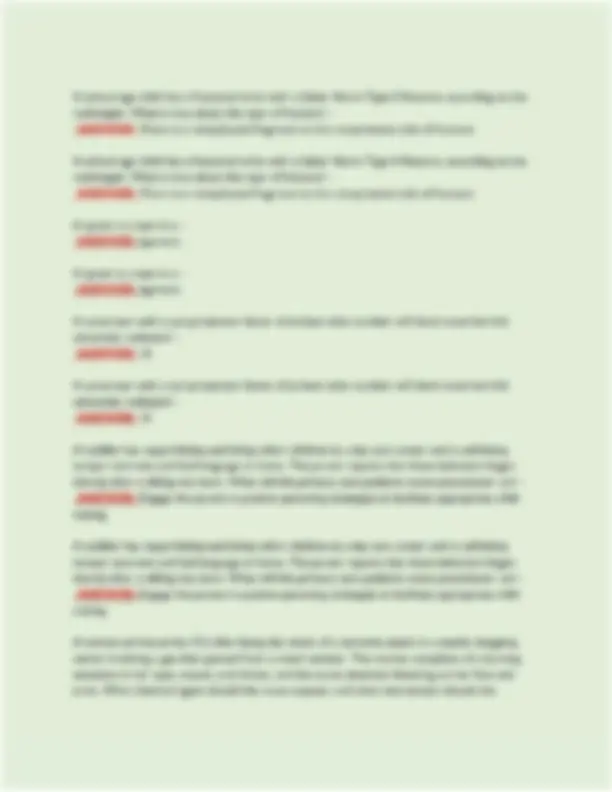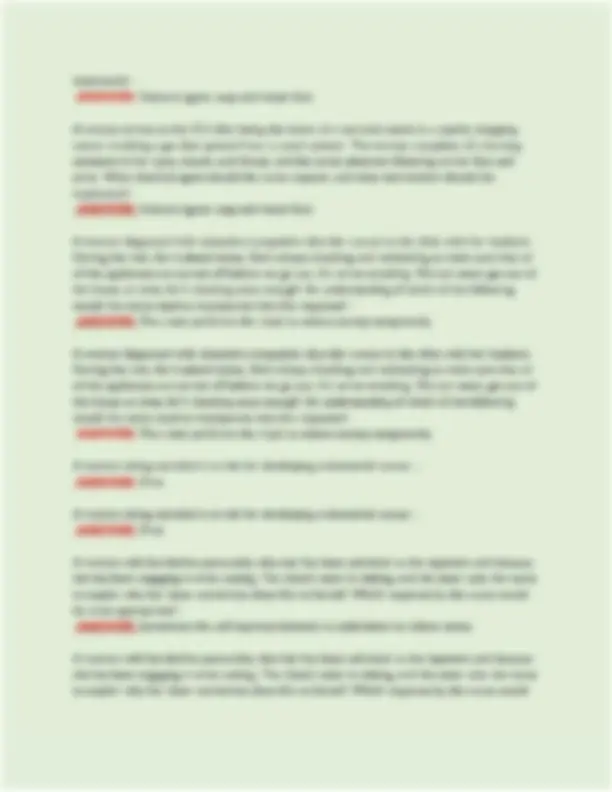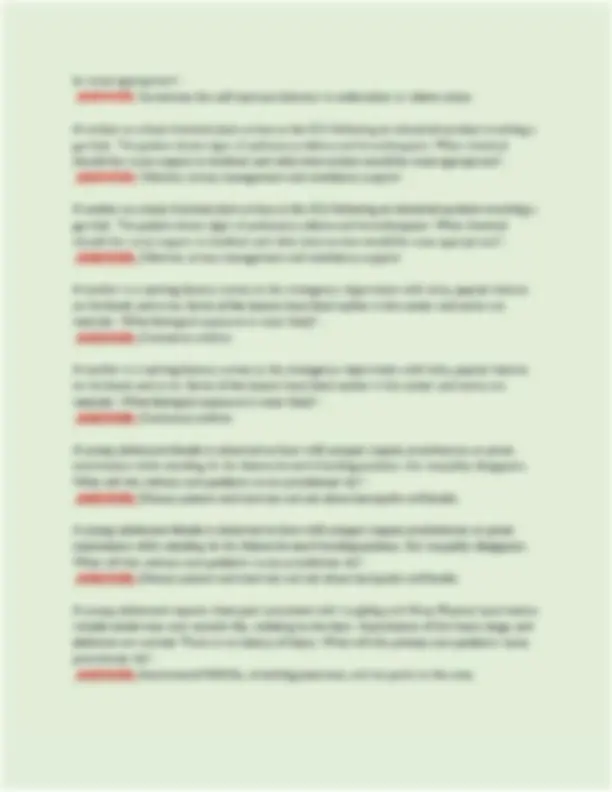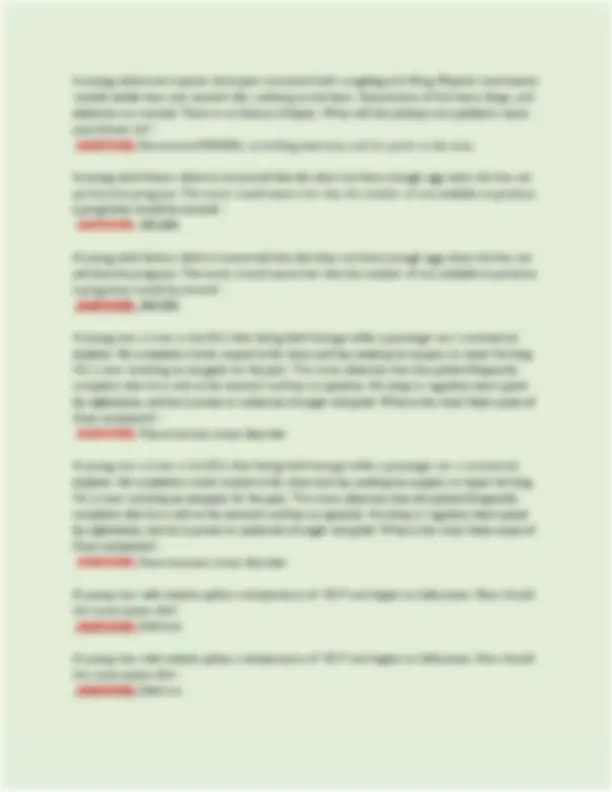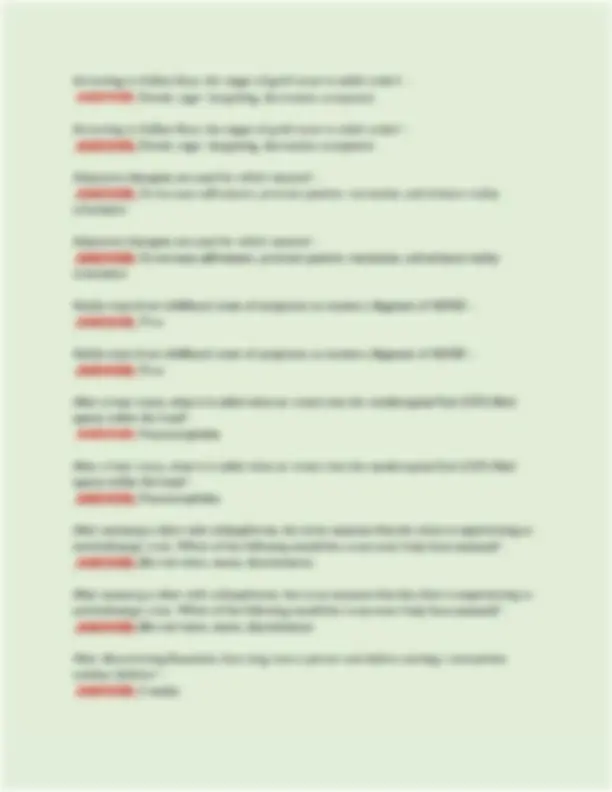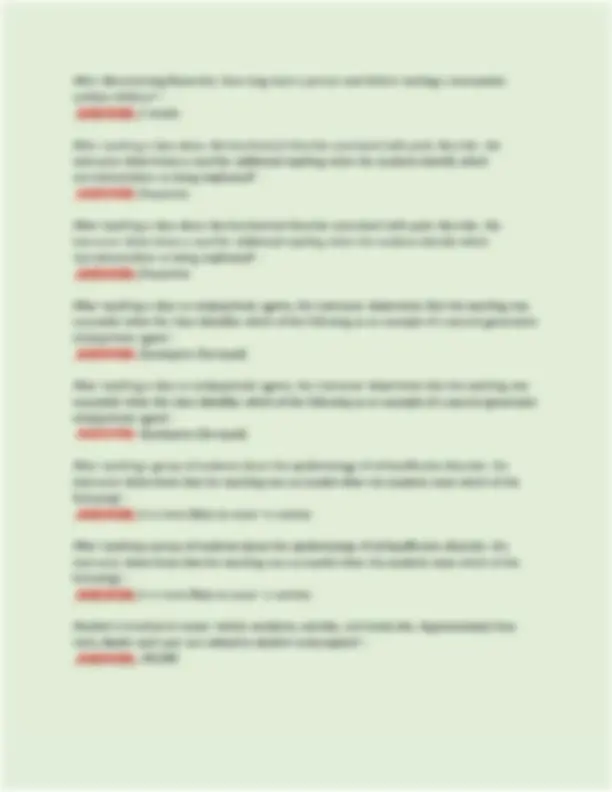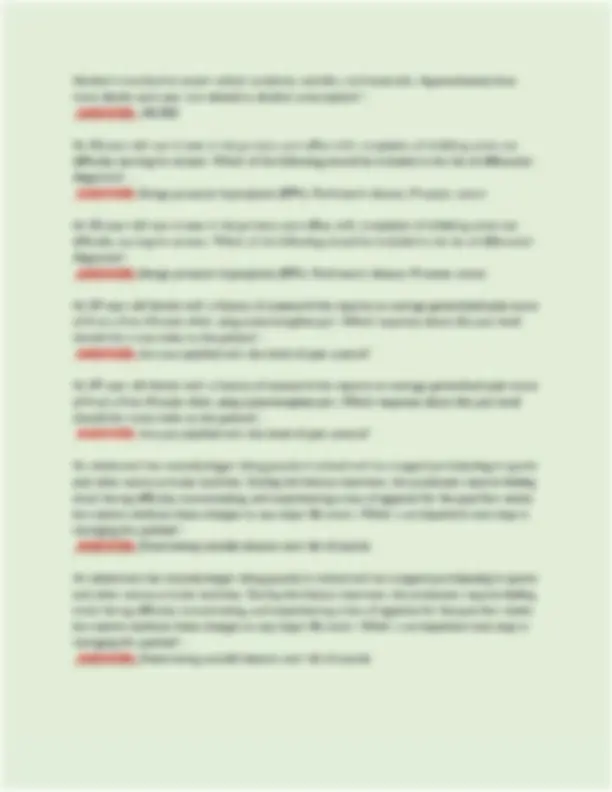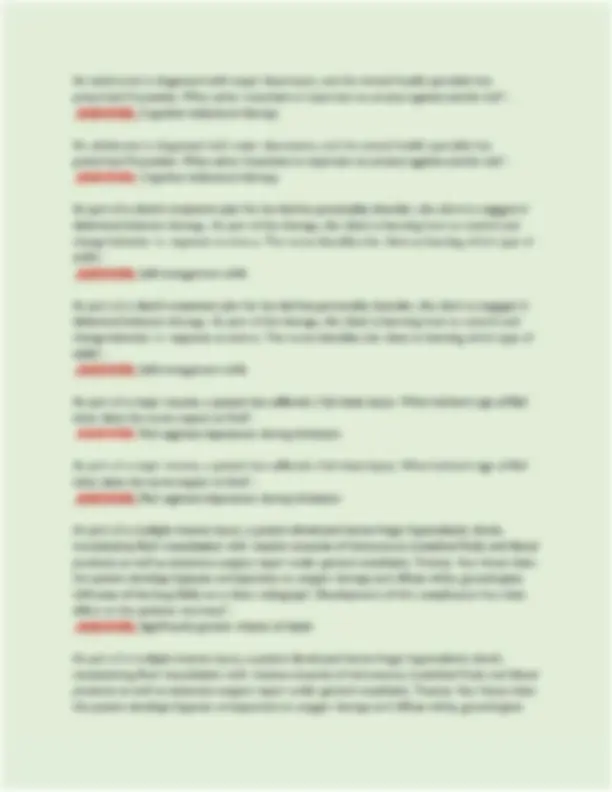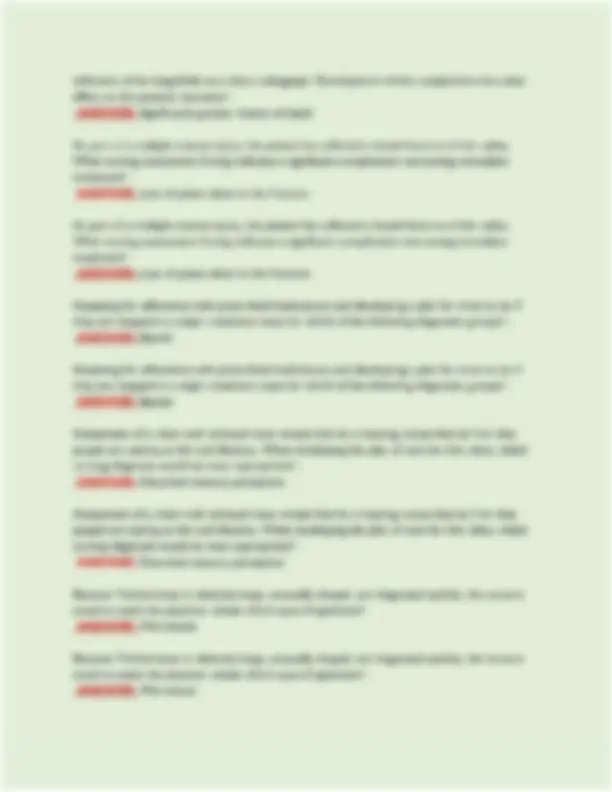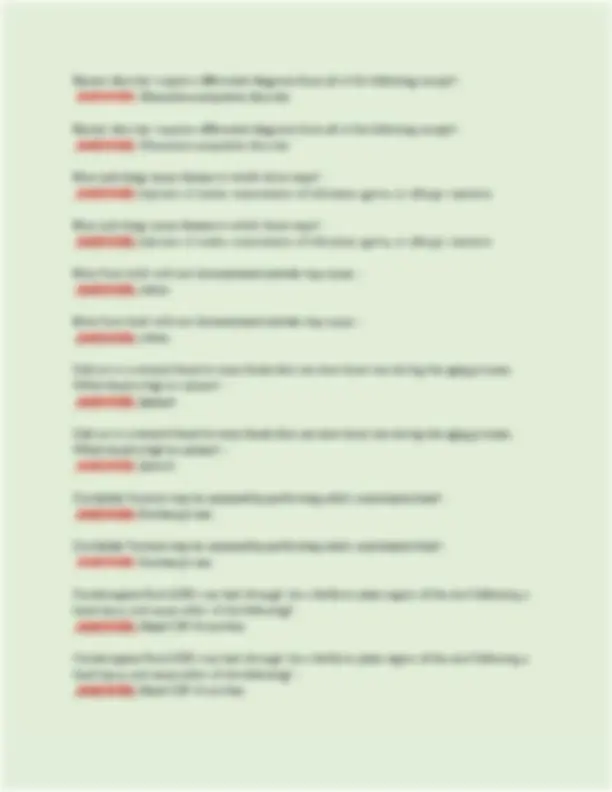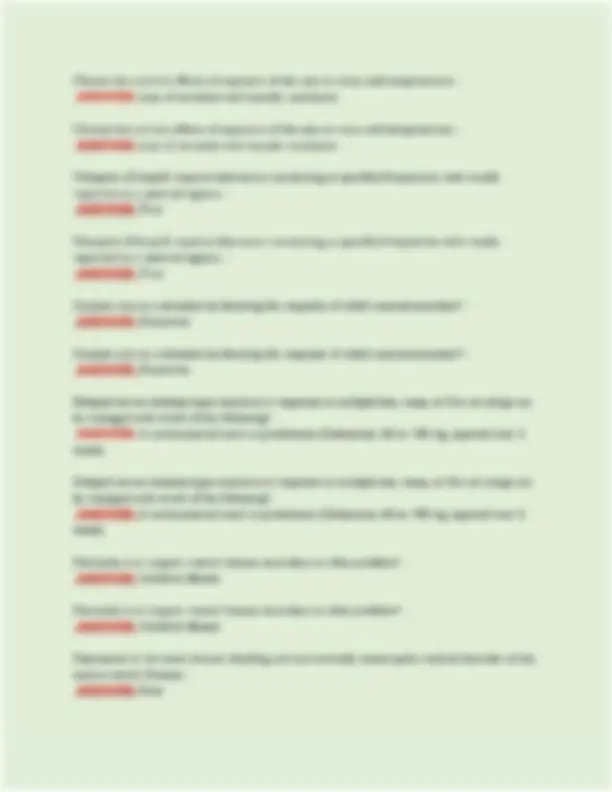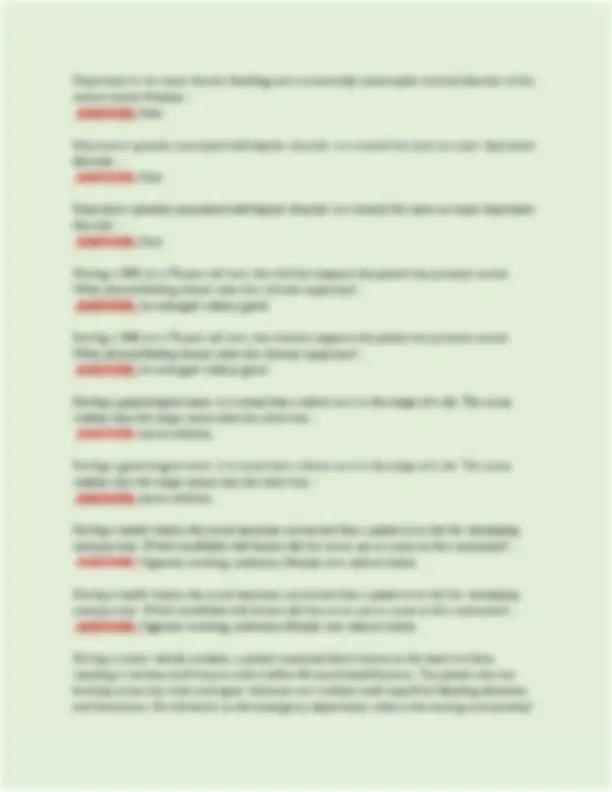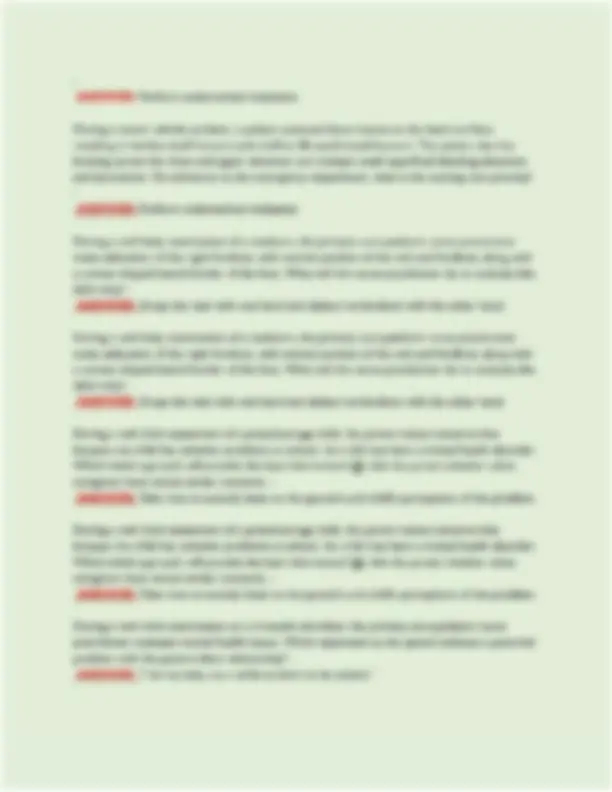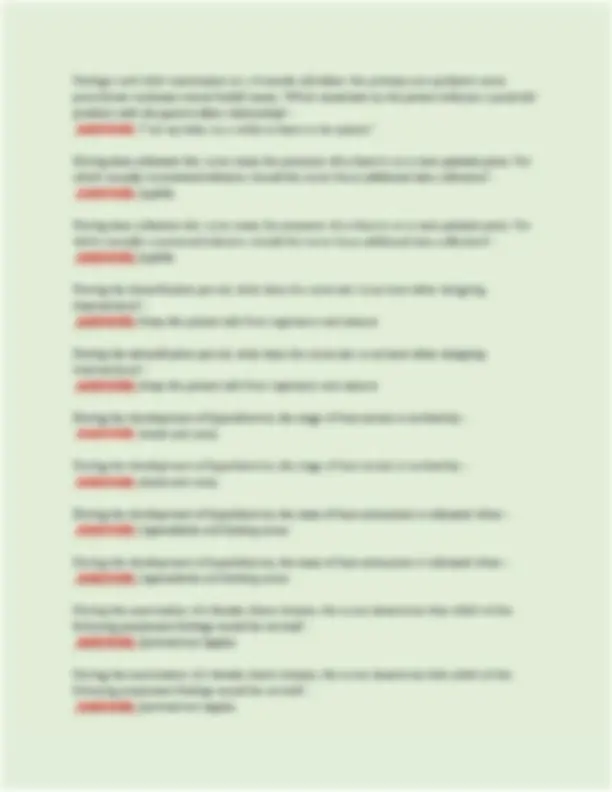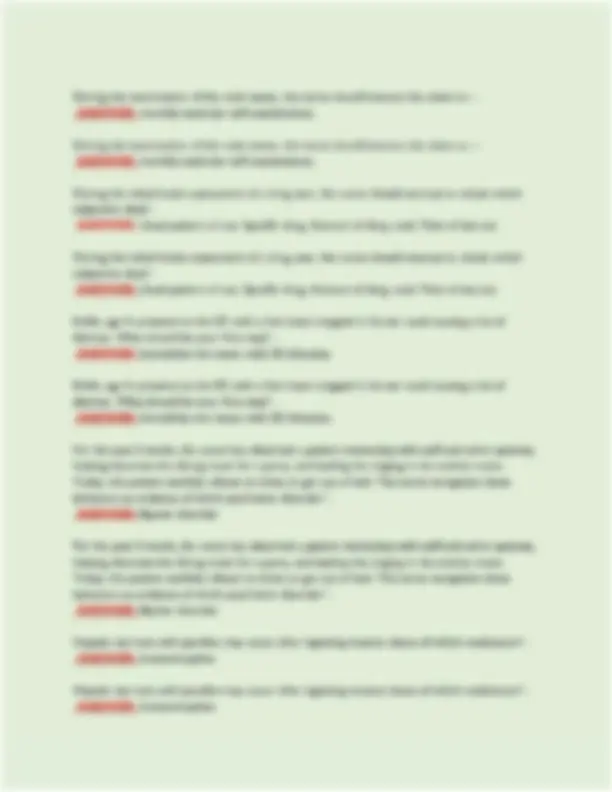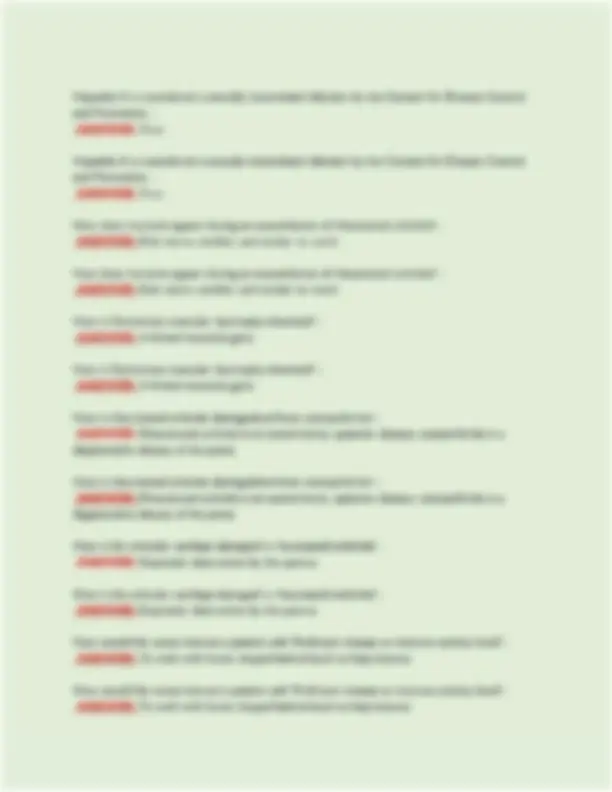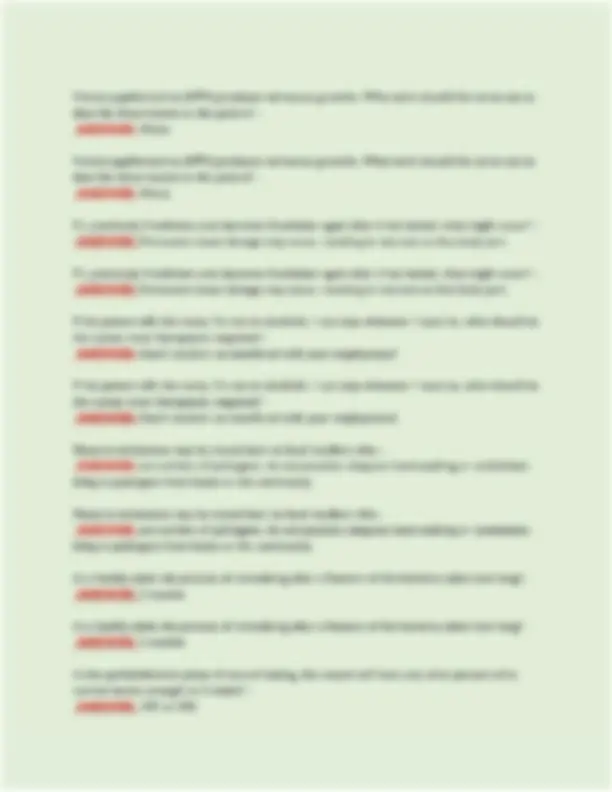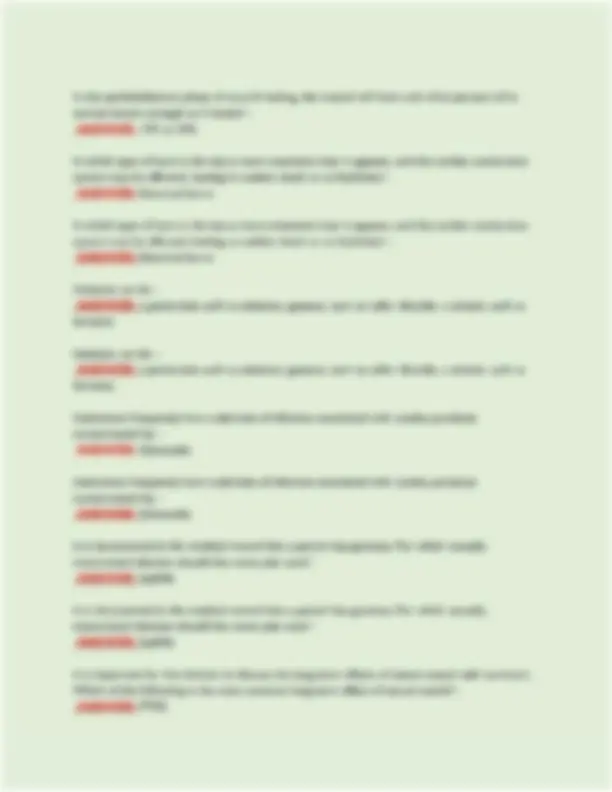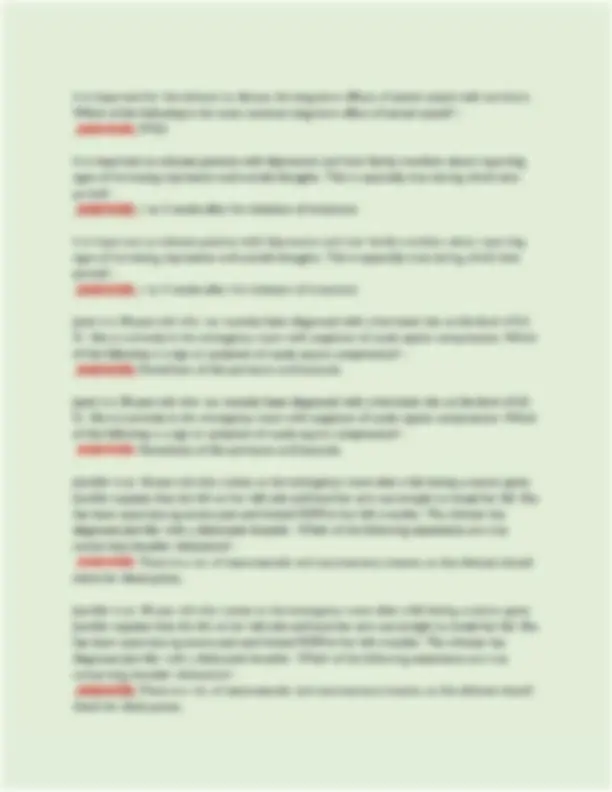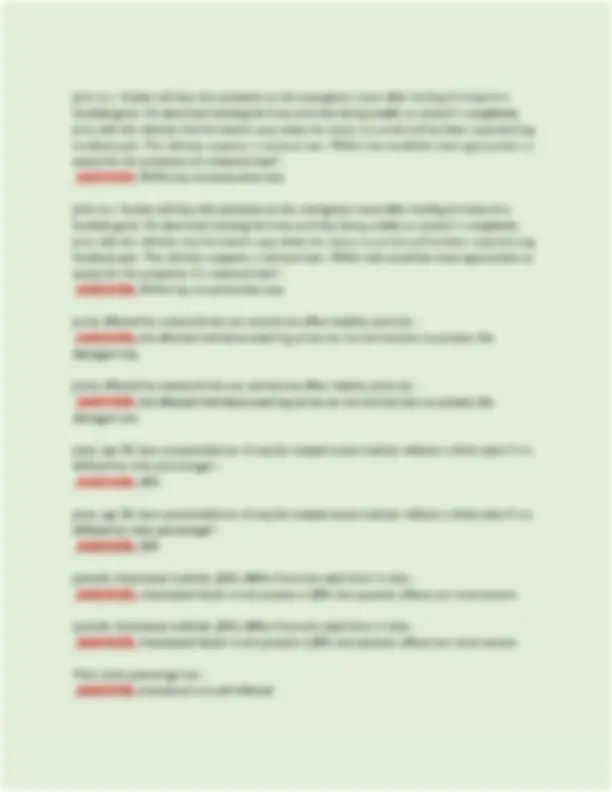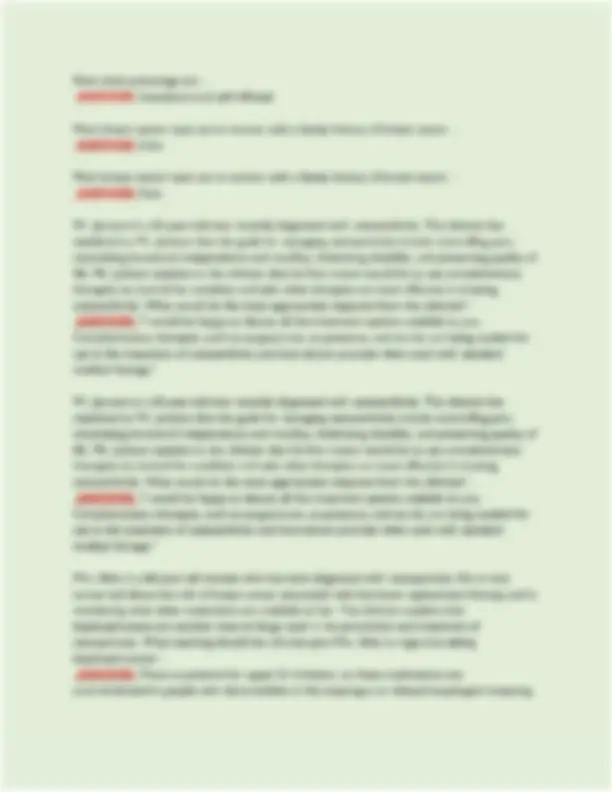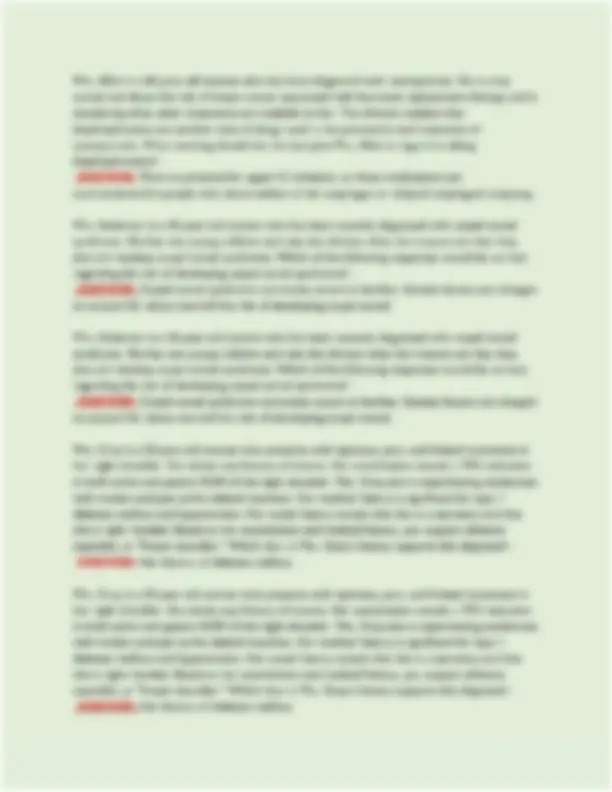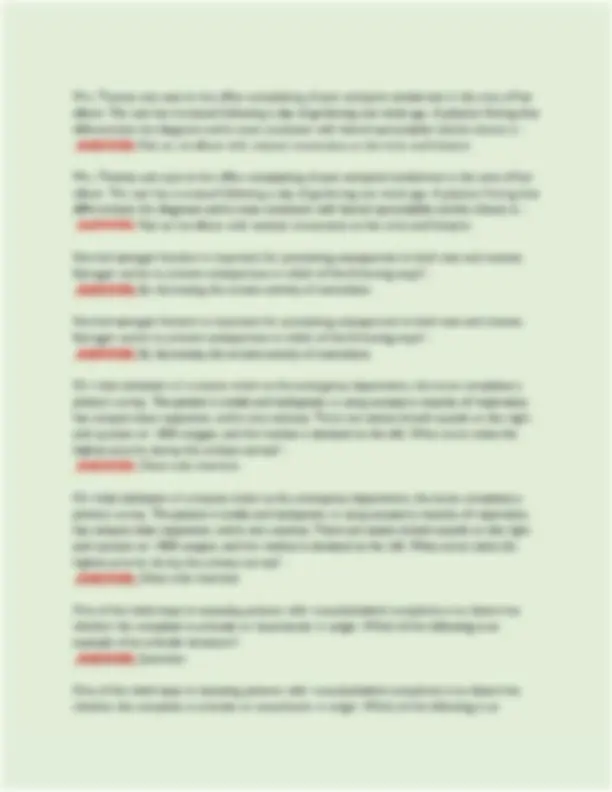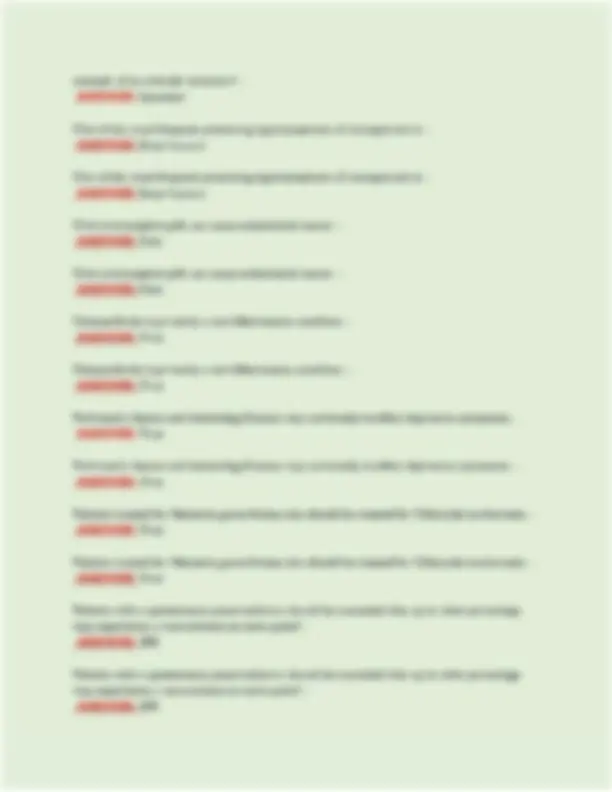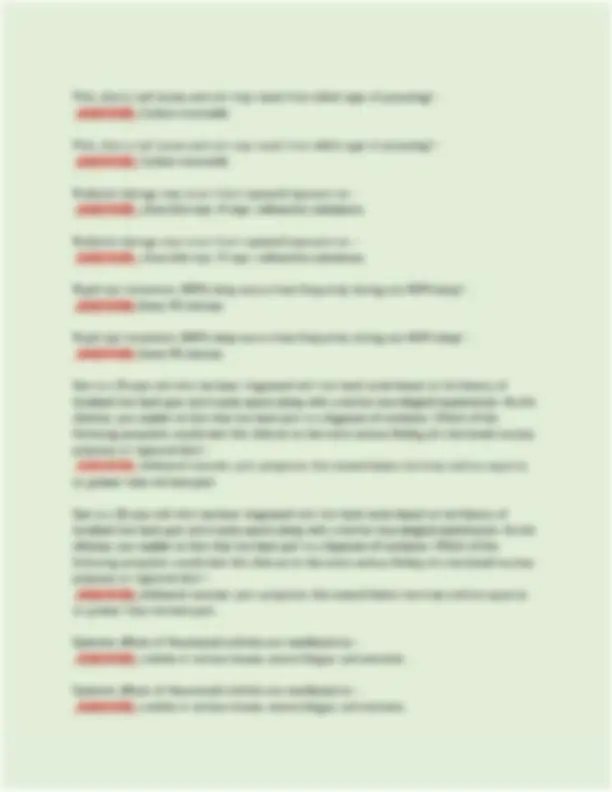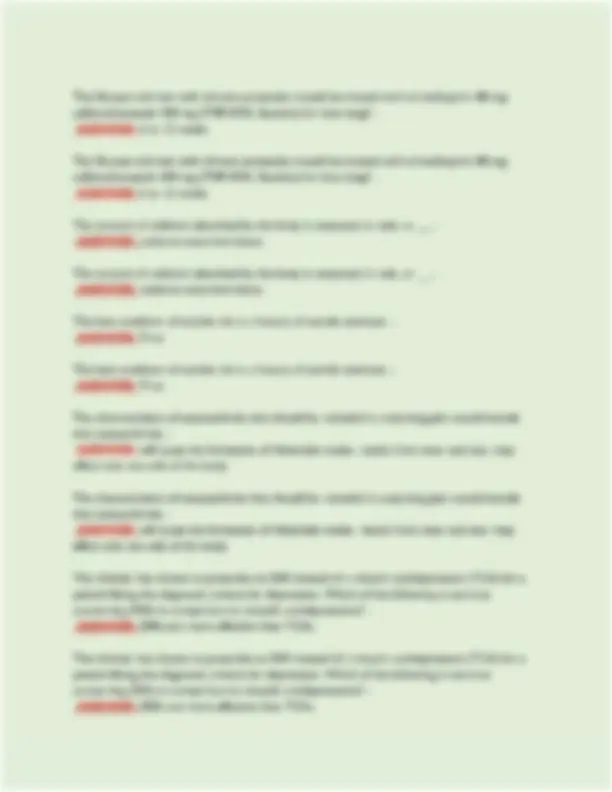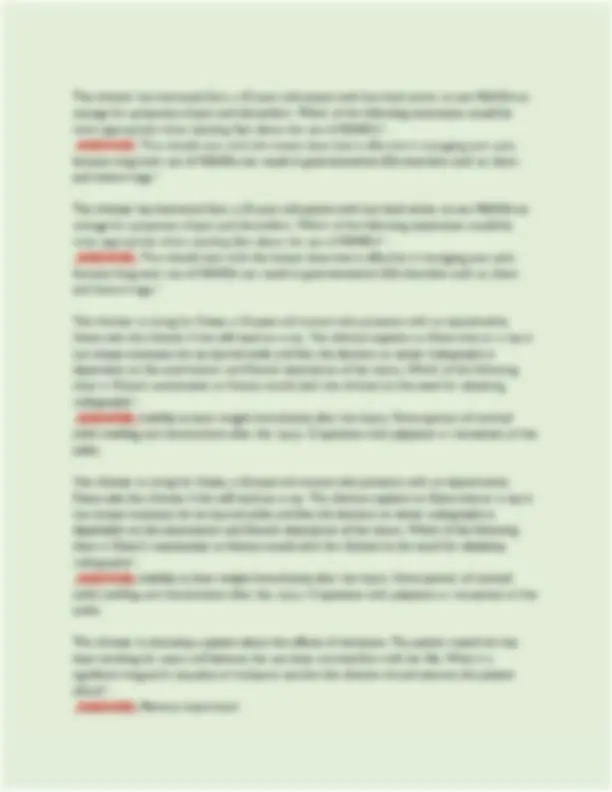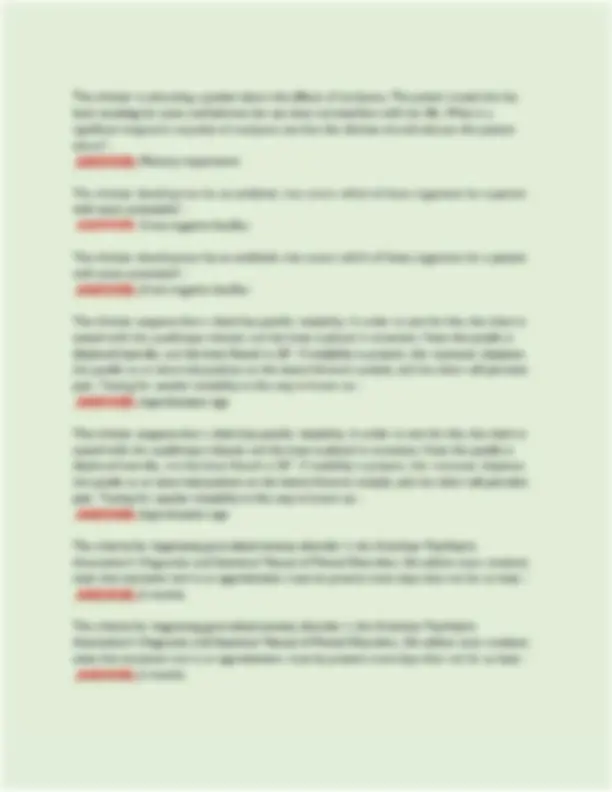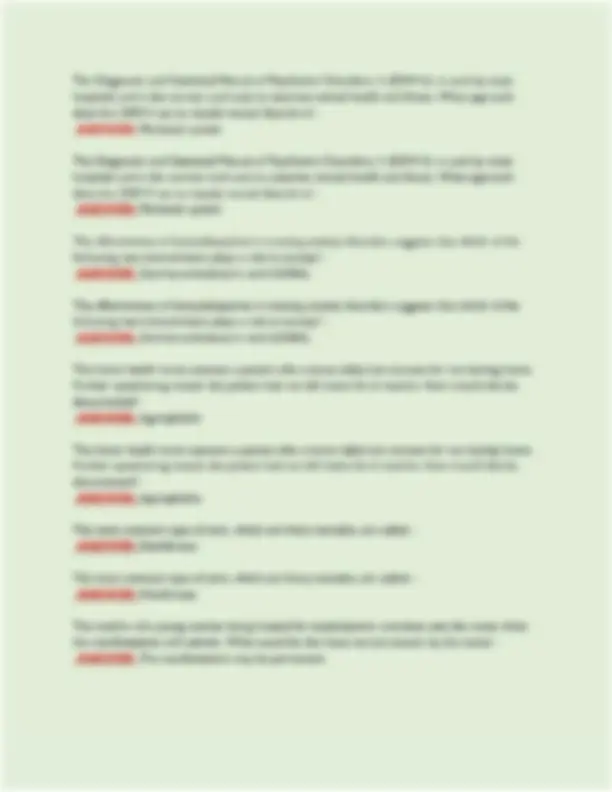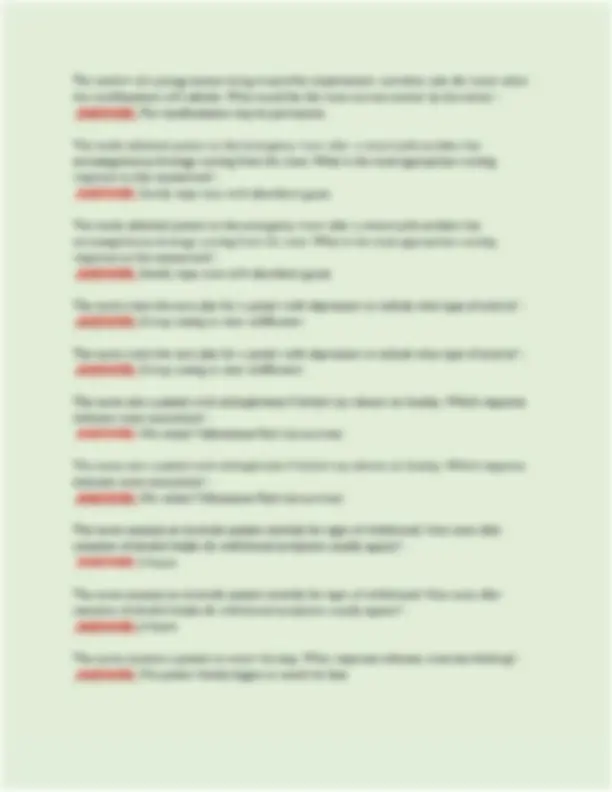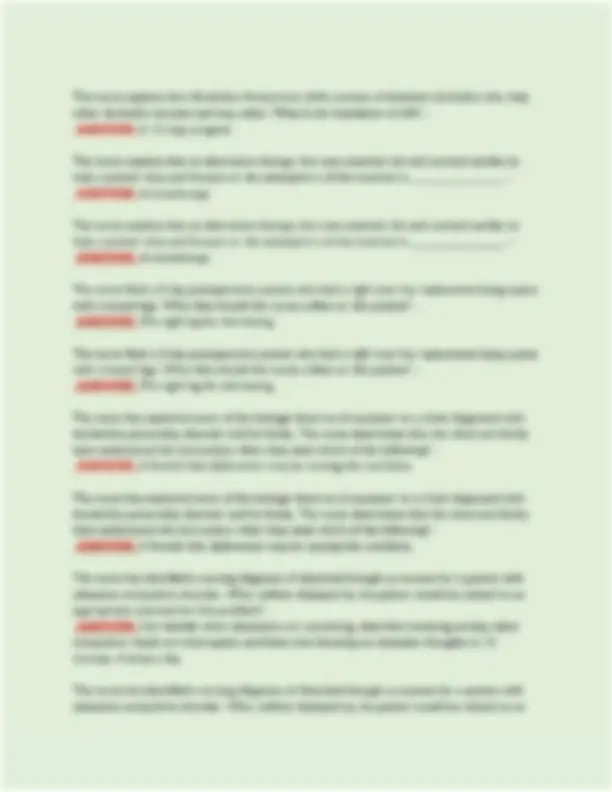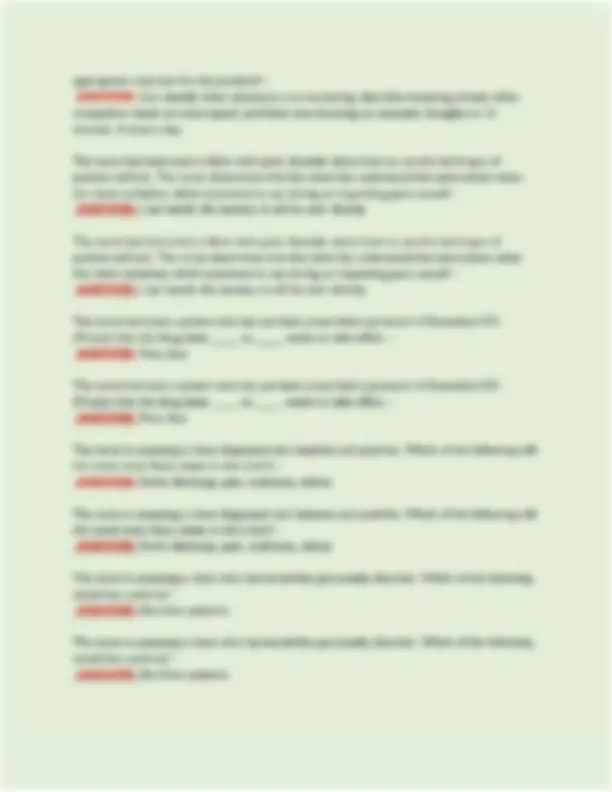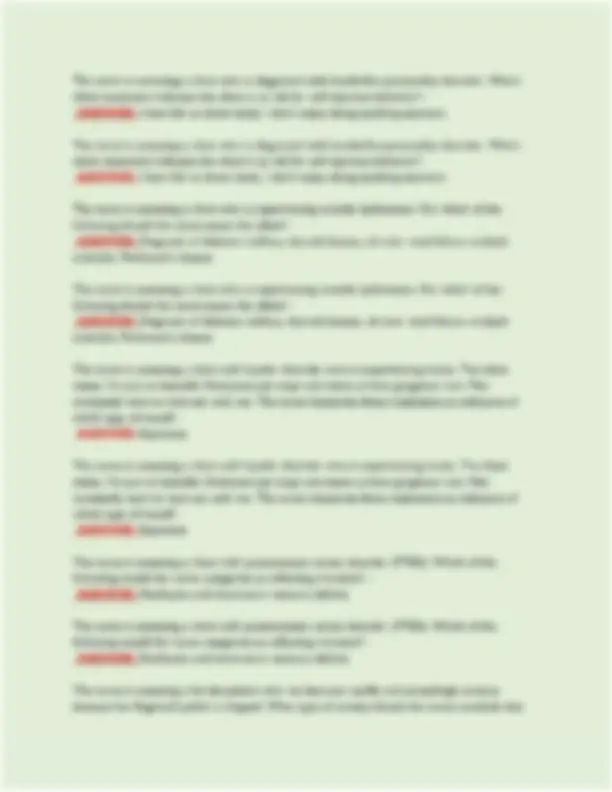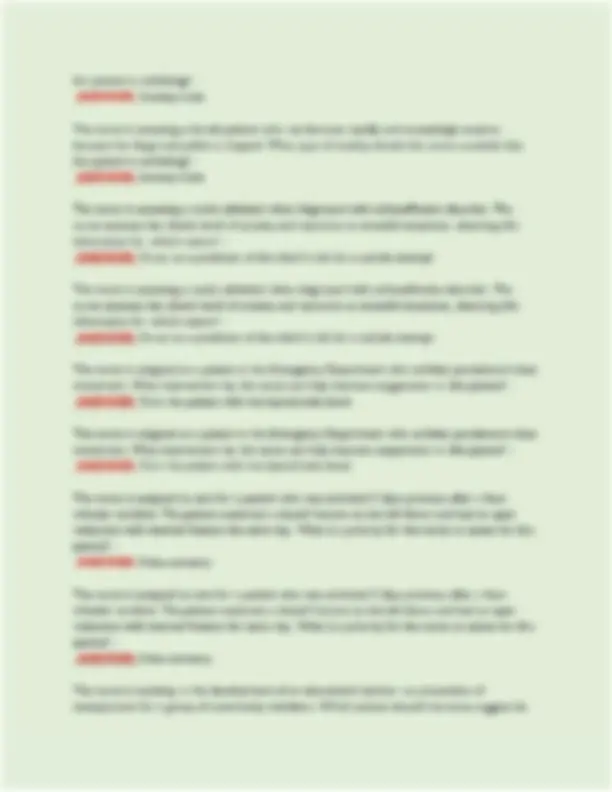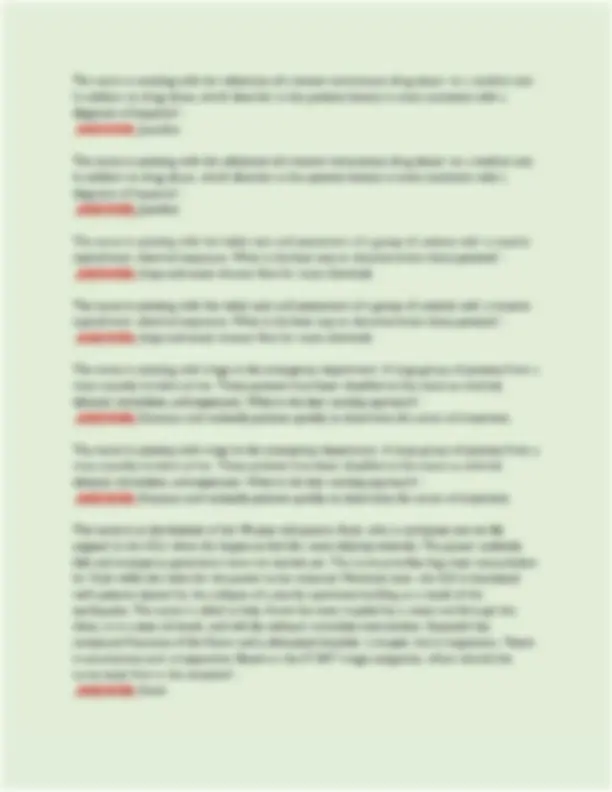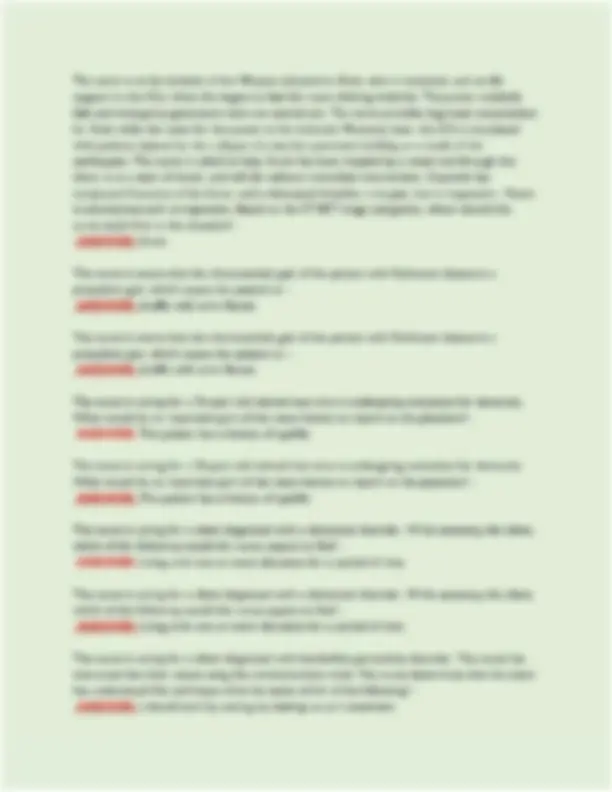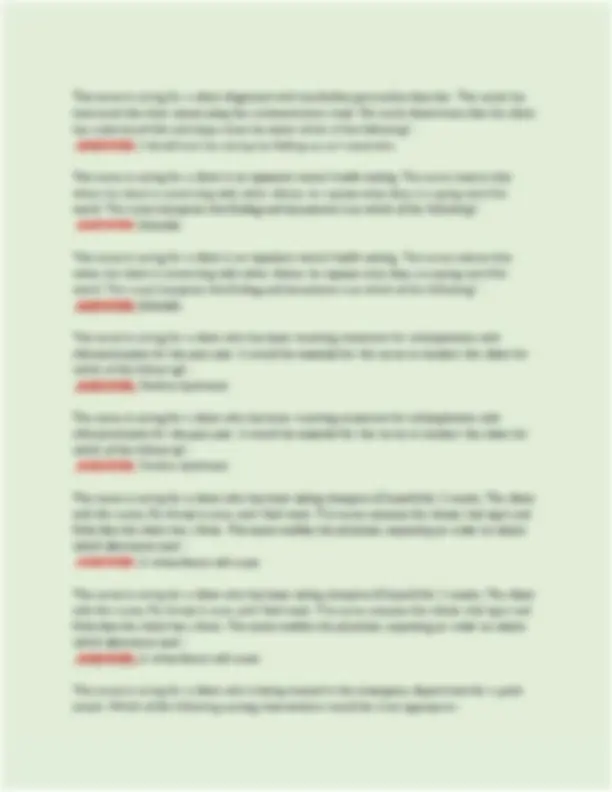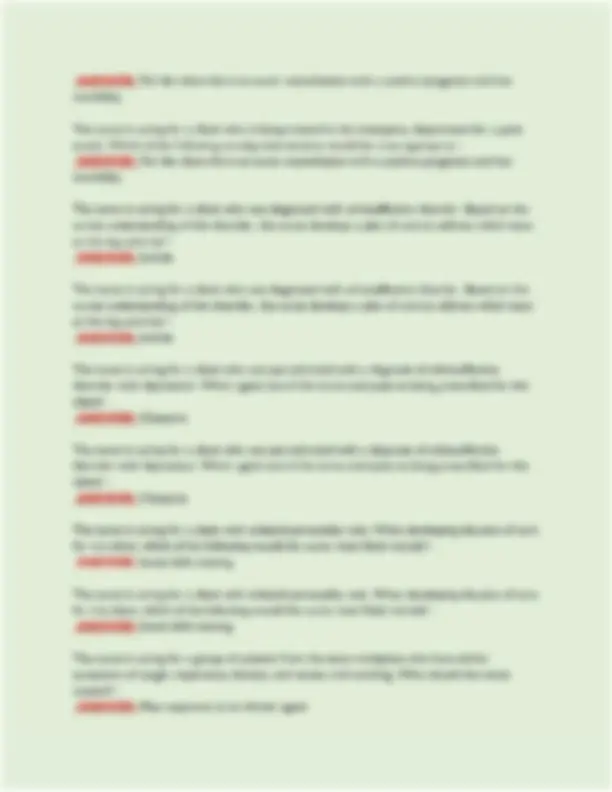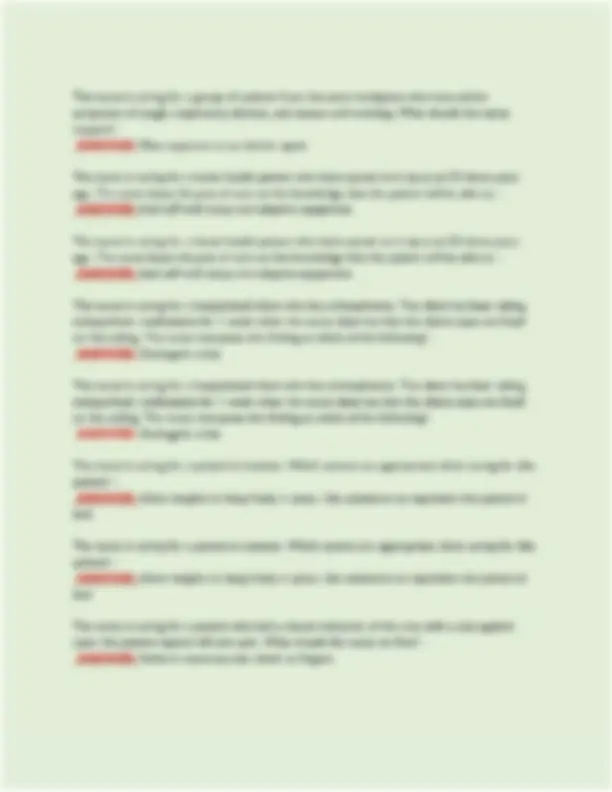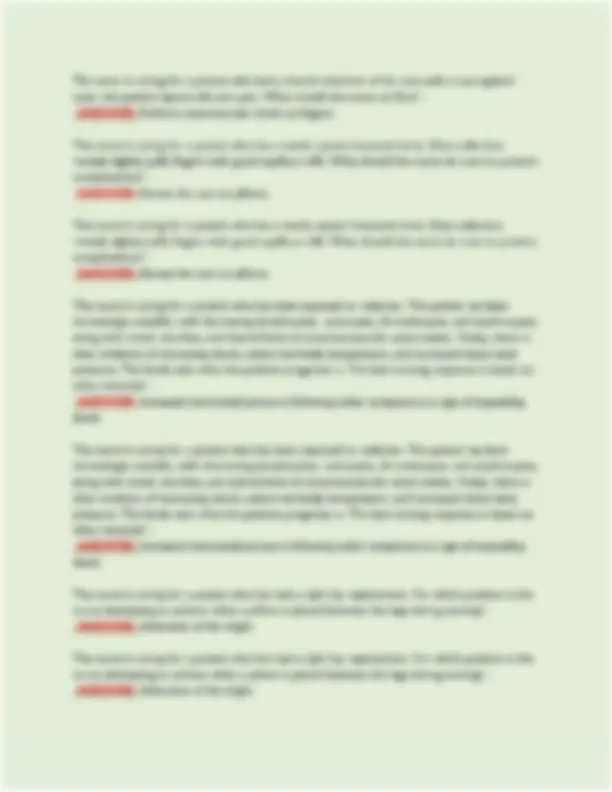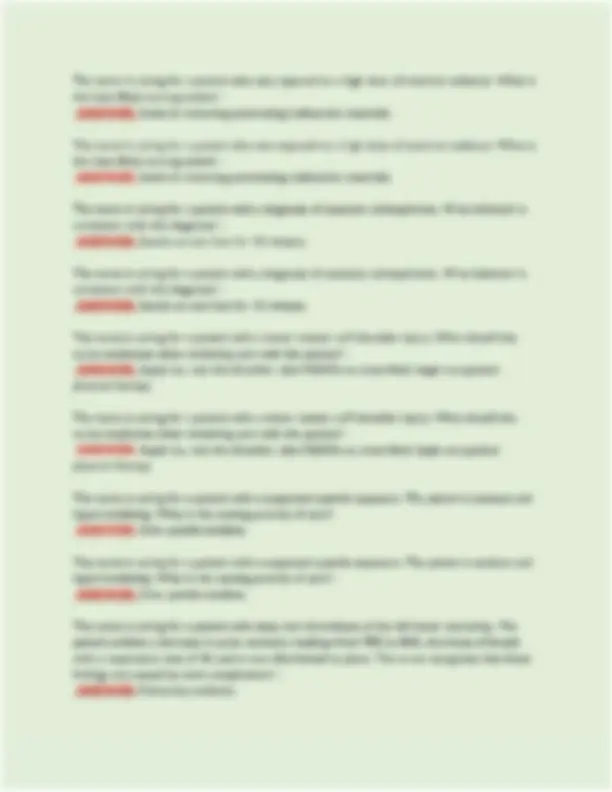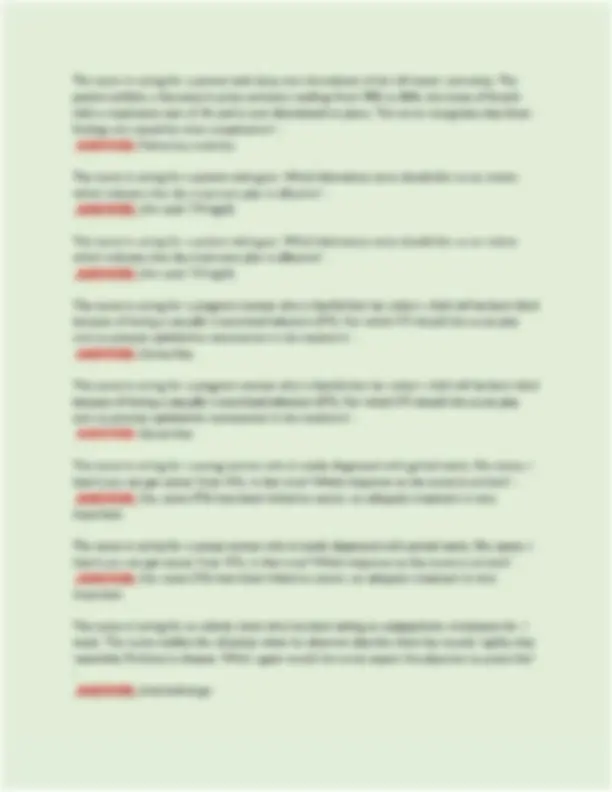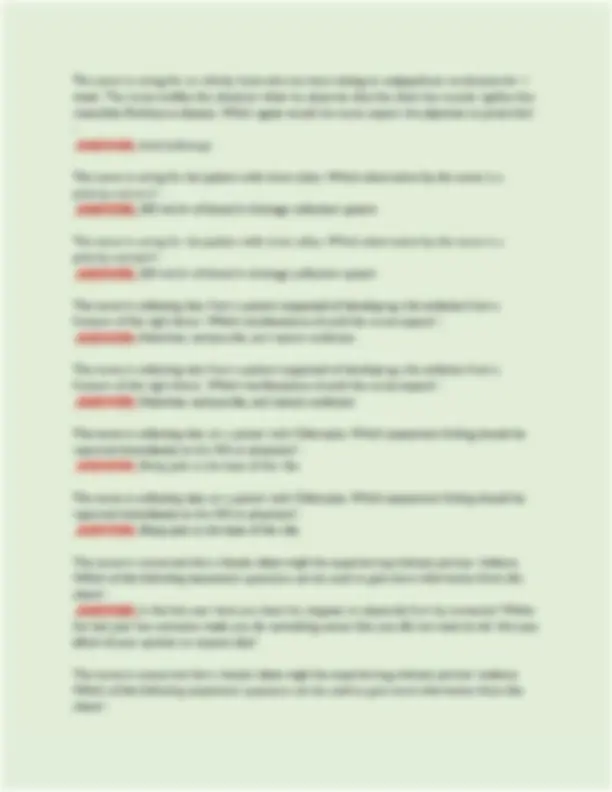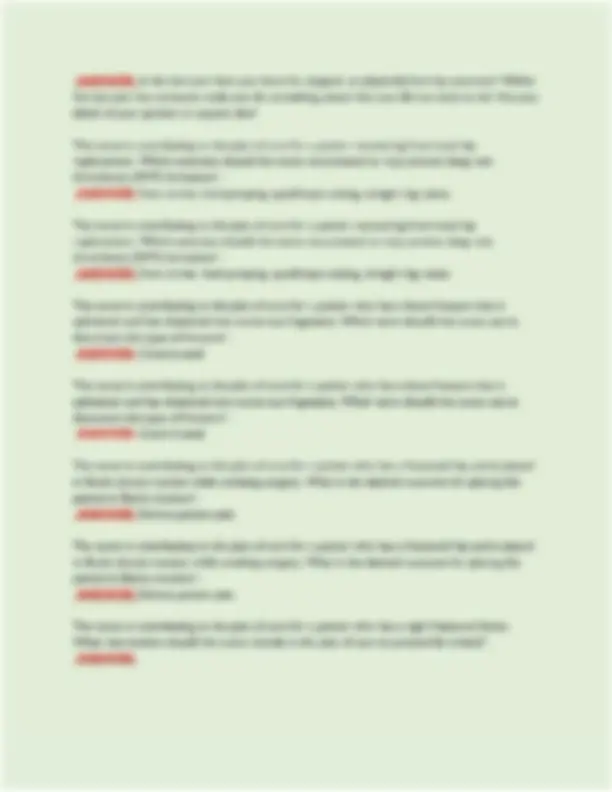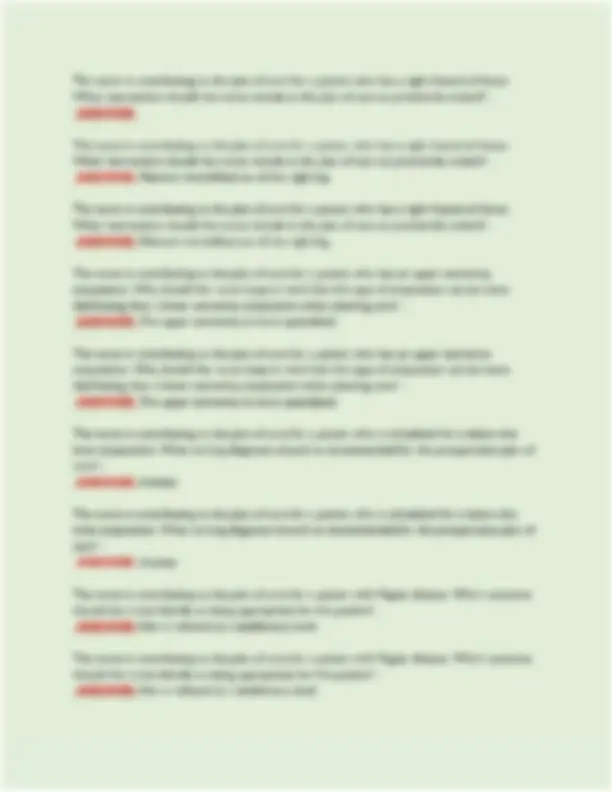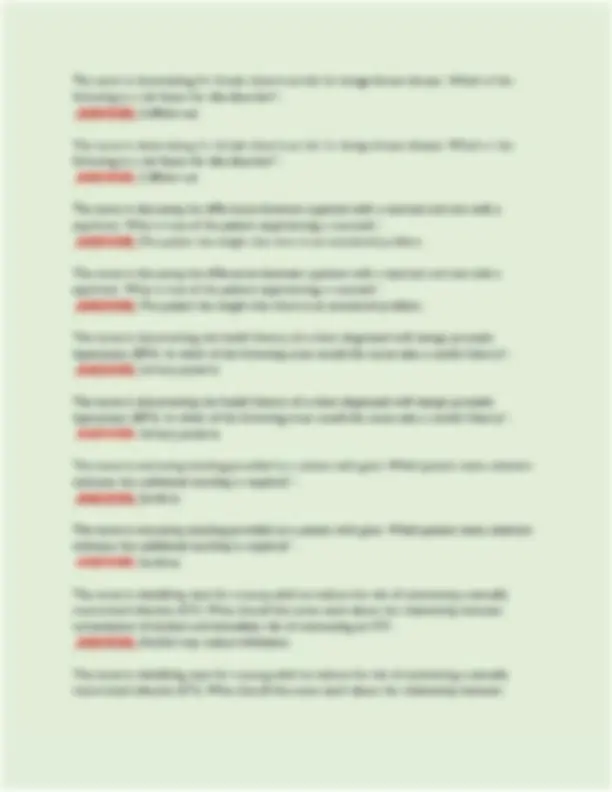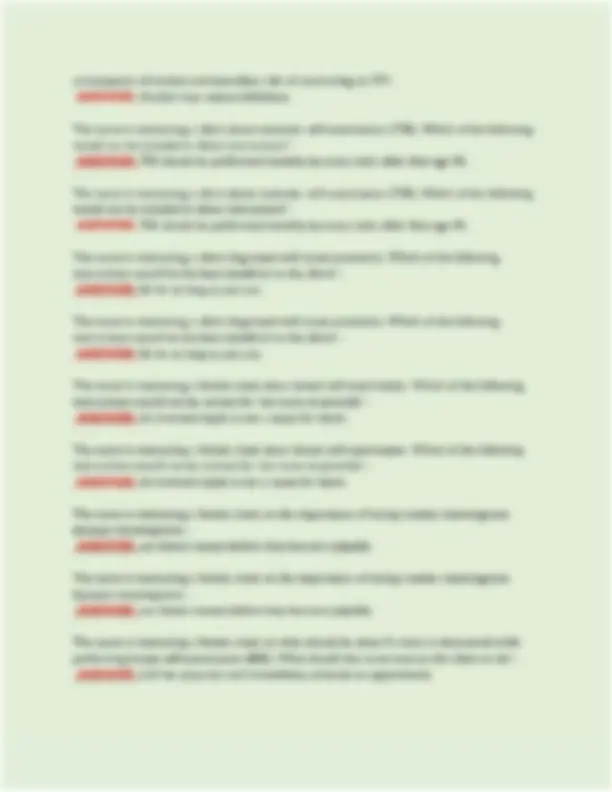Partial preview of the text
Download NU665C/ NU 665C Final Exam (Latest 2025/ 2026 Update) Psychiatric Mental Health Care of t and more Exams Nursing in PDF only on Docsity!
NU665C/ NU 665C Final Exam Psychiatric Mental Health Care of the Family Il Review| Questions & Answers| Grade A| 100% Correct (Verified Solutions)- Regis College 60-year-old man presents with an enlarged scrotum. The clinician uses a penlight to transilluminate the scrotum. In a patient with a hydrocele, what would the clinician expect to find? - ANSWER: The scrotum will appear light pink or yellow. 60-year-old man presents with an enlarged scrotum. The clinician uses a penlight to transilluminate the scrotum. In a patient with a hydrocele, what would the clinician expect to find? - ANSWER: The scrotum will appear light pink or yellow. A 13-year-old child has exhibited symptoms of mild depression for several weeks. The parent reports feeling relieved that the symptoms have passed but concerned that the child now seems to have boundless energy and an inability to sit still. What will the primary care pediatric nurse practitioner do? - ANSWER: Refer the child to a child psychiatrist for evaluation of bipolar disorder. A 13-year-old child has exhibited symptoms of mild depression for several weeks. The parent reports feeling relieved that the symptoms have passed but concerned that the child now seems to have boundless energy and an inability to sit still. What will the primary care pediatric nurse practitioner do? - ANSWER: Refer the child to a child psychiatrist for evaluation of bipolar disorder. A |4-year-old boy who is overweight develops a unilateral limp with pain in the hip and knee on the affected side. An exam reveals external rotation of the hip when flexed and pain associated with attempts to internally rotate the hip. What is most important initially when managing this child's condition? - ANSWER: Place the child on crutches or in a wheelchair to prevent weight-bearing. A 14-year-old boy who is overweight develops a unilateral limp with pain in the hip and knee on the affected side. An exam reveals external rotation of the hip when flexed and pain associated with attempts to internally rotate the hip. What is most important initially when managing this child's condition? - ANSWER: Place the child on crutches or in a wheelchair to prevent weight-bearing. A 14-year-old female comes to the clinic with amenorrhea for 3 months. A pregnancy test is negative. The adolescent's body weight is at 82% of expected for height and age. The mother reports that her daughter often throws up and refuses to eat most foods. Which condition does the primary care pediatric nurse practitioner suspect? - ANSWER: Anorexia nervosa A 14-year-old female comes to the clinic with amenorrhea for 3 months. A pregnancy test is negative. The adolescent's body weight is at 82% of expected for height and age. The mother reports that her daughter often throws up and refuses to eat most foods. Which condition does the primary care pediatric nurse practitioner suspect? - ANSWER: Anorexia nervosa A 14-year-old male is seen with complaints of severe testicular pain. The clinician suspects testicular torsion. Which of the following is the appropriate action? - ANSWER: Refer to a urologist immediately. A |4-year-old male is seen with complaints of severe testicular pain. The clinician suspects testicular torsion. Which of the following is the appropriate action? - ANSWER: Refer to a urologist immediately. A 14-year-old survivor of a school shooting screams and dives under a table when firecrackers go off. What does this behavior represent? - ANSWER: Post-traumatic stress disorder A 14-year-old survivor of a school shooting screams and dives under a table when firecrackers go off. What does this behavior represent? - ANSWER: Post-traumatic stress disorder A |4-year-old survivor of a school shooting screams and dives under a table when firecrackers go off. What does this behavior represent? - ANSWER: Post-traumatic stress disorder A 14-year-old survivor of a school shooting screams and dives under a table when firecrackers go off. What does this behavior represent? - ANSWER: Post-traumatic stress disorder A 15-year-old girl is seen in the clinic because she has not yet had her first period. Which of the following questions would help the clinician determine the cause? - ANSWER: "How long have you been underweight?" A 22-year-old patient presents in the emergency department with the characteristics of severe Parkinson disease. The nurse should suspect an overdose of what drug? - ANSWER: Amphetamines A 22-year-old patient presents in the emergency department with the characteristics of severe Parkinson disease. The nurse should suspect an overdose of what drug? - ANSWER: Amphetamines A 22-year-old woman is diagnosed with premenstrual syndrome. Which of the following lifestyle changes should the clini ANSWER: Regular exercise ian suggest to help minimize the patient's symptoms? - A 22-year-old woman is diagnosed with premenstrual syndrome. Which of the following lifestyle changes should the clinician suggest to help minimize the patient's symptoms? - ANSWER: Regular exercise A 23-year-old sexually active man is seen in the clinic with unilateral painful testicular swelling, and he is diagnosed with epididymitis. In order to prescribe the correct drug, the clinician must understand that which of these is the most common causative organism? - ANSWER: Chlamydia trachomatis A 23-year-old sexually active man is seen in the clinic with unilateral painful testicular swelling, and he is diagnosed with epididymitis. In order to prescribe the correct drug, the clinician must understand that which of these is the most common causative organism? - ANSWER: Chlamydia trachomatis A 23-year-old sexually active woman presents for her first Pap smear. Her history includes nulligravida, age at first intercourse 14, and more than |0 sexual partners. Which of the following conditions should the clinician be particularly alert for during her examination? - ANSWER: Human papillomavirus A 23-year-old sexually active woman presents for her first Pap smear. Her history includes nulligravida, age at first intercourse 14, and more than 10 sexual partners. Which of the following conditions should the clinician be particularly alert for during her examination? - ANSWER: Human papillomavirus A 24-year-old woman diagnosed with Chlamydia has been prescribed doxycycline. What should be included in the nurses teaching about the drug treatment? - ANSWER: Do not take with dairy products, avoid unnecessary exposure to sunlight, use birth control methods to ensure you do not become pregnant A 24-year-old woman diagnosed with Chlamydia has been prescribed doxycycline. What should be included in the nurses teaching about the drug treatment? - ANSWER: Do not take with dairy products, avoid unnecessary exposure to sunlight, use birth control methods to ensure you do not become pregnant A 24-year-old woman presents to the clinic with dysuria, dyspareunia, and a mucopurulent vaginal discharge. Her boyfriend was recently treated for nongonococcal urethritis. What sexually transmitted disease has she most probably been exposed to? - ANSWER: Chlamydia A 24-year-old woman presents to the clinic with dysuria, dyspareunia, and a mucopurulent vaginal discharge. Her boyfriend was recently treated for nongonococcal urethritis. What sexually transmitted disease has she most probably been exposed to? - ANSWER: Chlamydia A 25-year-old woman is seen in the clinic complaining of painful menstruation. Which of the following pelvic pathologies is the most common cause of dysmenorrhea? - ANSWER: Endometriosis A 25-year-old woman is seen in the clinic complaining of painful menstruation. Which of the following pelvic pathologies is the most common cause of dysmenorrhea? - ANSWER: Endometriosis A 26-year-old woman is seen with complaints of irregular vaginal bleeding. Which of the following tests should be the first priority? - ANSWER: Pregnancy test A 26-year-old woman is seen with complaints of irregular vaginal bleeding. Which of the following tests should be the first priority? - ANSWER: Pregnancy test A 26-year-old woman tells the clinician that she has endometriosis, because she has frequent pelvic pain. The clinician also should consider which of these differential diagnoses? - ANSWER: Ovarian cysts A 26-year-old woman tells the clinician that she has endometriosis, because she has frequent pelvic pain. The clinician also should consider which of these differential diagnoses? - ANSWER: Ovarian cysts Which of the following treatments would be appropriate? - ANSWER: Fluconazole A 36-year-old woman is seen with complaints of vaginal itching, burning, and discharge. On potassium hydroxide (KOH) wet mount of vaginal discharge, the clinician notices hyphae. Which of the following treatments would be appropriate? - ANSWER: Fluconazole A 40-year-old woman is seen for her yearly examination. She is single and not in a monogamous relationship. Her social history includes smoking cigarettes "occasionally" and drinking about two beers a day. Her body mass index (BMI) is 25. She is requesting birth control. Which of the following methods would be best for this patient? - ANSWER: Condom A 40-year-old woman is seen for her yearly examination. She is single and not in a monogamous relationship. Her social history includes smoking cigarettes "occasionally" and drinking about two beers a day. Her body mass index (BMI) is 25. She is requesting birth control. Which of the following methods would be best for this patient? - ANSWER: Condom A 42-year-old woman presents to the clinic with complaints of painful intercourse for the last month. Which of the following should be explored as the likely cause of her dyspareunia? - ANSWER: Menopause A 42-year-old woman presents to the clinic with complaints of painful intercourse for the last month. Which of the following should be explored as the likely cause of her dyspareunia? - ANSWER: Menopause A 44-year-old patient with breast cancer is prescribed tamoxifen by her surgeon. She is complaining about hot flashes. Which of the following responses by the clinician would be most appropriate? - ANSWER: "The hot flashes are a result of the antiestrogenic effects of tamoxifen." A 44-year-old patient with breast cancer is prescribed tamoxifen by her surgeon. She is complaining about hot flashes. Which of the following responses by the clinician would be most appropriate? - ANSWER: "The hot flashes are a result of the antiestrogenic effects of tamoxifen." A 45-year-old woman is seen because of irregular menstrual periods. Her follicle-stimulating hormone (FSH) level is 48 mIU/mL, and her luteinizing hormone (LH) level is elevated. She asks the clinician what this means. Which would be the best response? - ANSWER: "You are approaching menopause.” A 45-year-old woman is seen because of irregular menstrual periods. Her follicle-stimulating hormone (FSH) level is 48 mlU/mL, and her luteinizing hormone (LH) level is elevated. She asks the clinician what this means. Which would be the best response? - ANSWER: "You are approaching menopause.” A 45-year-old woman is seen in the clinic with abnormal uterine bleeding and pain during intercourse. The clinician should consider which of the following diagnoses? - ANSWER: Leiomyoma, pregnancy, ovarian cancer A 45-year-old woman is seen in the clinic with abnormal uterine bleeding and pain during intercourse. The clinician should consider which of the following diagnoses? - ANSWER: Leiomyoma, pregnancy, ovarian cancer A 45-year-old woman is seen in the clinic with complaints of a vaginal discharge. The clinician identifies clue cells on the vaginal smear. Which of the following diagnoses is associated with this finding? - ANSWER: Bacterial Vaginosis A 45-year-old woman is seen in the clinic with complaints of a vaginal discharge. The clinician identifies clue cells on the vaginal smear. Which of the following diagnoses is associated with this finding? - ANSWER: Bacterial Vaginosis A 46-year-old man presents with urinary hesitancy and low back pain. He has no history of UTI. Digital rectal examination (DRE) reveals a normal prostate, and a diagnosis of prostatodynia is made. Which is the appropriate treatment? - ANSWER: Terazosin 2 mg PO once a day A 46-year-old man presents with urinary hesitancy and low back pain. He has no history of UTI. Digital rectal examination (DRE) reveals a normal prostate, and a diagnosis of prostatodynia is made. Which is the appropriate treatment? - ANSWER: Terazosin 2 mg PO once a day A 48-year-old woman is seen in the clinic with complaints of prolonged heavy menstrual periods. She is pale and states she can no longer exercise. Pelvic exam reveals a single, very large mass. Which of the following diagnostic tests should the clinician order first? - ANSWER: Transvaginal ultrasound A 58-year-old woman, who had a total abdominal hysterectomy at the age of 45, is diagnosed with atrophic vaginitis. Which of the following is the most appropriate treatment? - ANSWER: Estradiol 7.5 mcg/24 hr vaginal ring A 58-year-old woman, who had a total abdominal hysterectomy at the age of 45, is diagnosed with atrophic vaginitis. Which of the following is the most appropriate treatment? - ANSWER: Estradiol 7.5 mcg/24 hr vaginal ring A 60-year-old man was admitted for cholecystitis that resulted in a cholecystectomy. On his third day of hospitalization, he begins to sweat profusely, tremble, and has a blood pressure of 160/100. Based on these findings, what focused assessment should the nurse complete? - ANSWER: Withdrawal problems A 60-year-old man was admitted for cholecystitis that resulted in a cholecystectomy. On his third day of hospitalization, he begins to sweat profusely, tremble, and has a blood pressure of 160/100. Based on these findings, what focused assessment should the nurse complete? - ANSWER: Withdrawal problems A 60-year-old woman is seen for an annual checkup. Her obstetric history reveals para 6, gravida 6. She reports that she went through menopause at age 45. Her grandmother died at age 80 of colon cancer, and her father died of lung cancer. What in her history would be a risk factor for ovarian cancer? - ANSWER: Her grandmother's history of colon cancer A 60-year-old woman is seen for an annual checkup. Her obstetric history reveals para 6, gravida 6. She reports that she went through menopause at age 45. Her grandmother died at age 80 of colon cancer, and her father died of lung cancer. What in her history would be a risk factor for ovarian cancer? - ANSWER: Her grandmother's history of colon cancer A 63-year-old man is seen in the clinic with a chief complaint of nocturia. Which of the following should be included in the differential diagnosis? - ANSWER: Benign prostatic hypertrophy A 63-year-old man is seen in the clinic with a chief complaint of nocturia. Which of the following should be included in the differential diagnosis? - ANSWER: Benign prostatic hypertrophy A 70-year-old female has fallen 2 weeks ago and developed immediate pain in her left wrist. She thought she just bruised it but is worried because it has not improved. She has used Tylenol® and ice at home, and that has helped slightly. You examine her and find she has moderate swelling and ecchymosis but no overtly obvious deformity. Her ROM is uncomfortable and severely diminished due to the pain. No crepitus is heard or felt. Her fingers are warm; her pulse is strong; and capillary refill is less than 2 seconds. What should you do? - ANSWER: Obtain a wrist x-ray and place her wrist in a splint or prescribe a splint. A 70-year-old female has fallen 2 weeks ago and developed immediate pain in her left wrist. She thought she just bruised it but is worried because it has not improved. She has used Tylenol® and ice at home, and that has helped slightly. You examine her and find she has moderate swelling and ecchymosis but no overtly obvious deformity. Her ROM is uncomfortable and severely diminished due to the pain. No crepitus is heard or felt. Her fingers are warm; her pulse is strong; and capillary refill is less than 2 seconds. What should you do? - ANSWER: Obtain a wrist x-ray and place her wrist in a splint or prescribe a splint. A 76-year-old man is seen in the office for complaints of urinary incontinence. The clinician should explore which of these causes of incontinence in men? - ANSWER: Urinary tract infection (UTI) A 76-year-old man is seen in the office for complaints of urinary incontinence. The clinician should explore which of these causes of incontinence in men? - ANSWER: Urinary tract infection (UTI) A 78-year-old man is diagnosed with C2 prostate cancer, and he asks the clinician what that means. In order to answer the patient, the clinician must have which of these understandings of the Jewett rating system? - ANSWER: The cancer involves the seminal vesicles. A 78-year-old man is diagnosed with C2 prostate cancer, and he asks the clinician what that means. In order to answer the patient, the clinician must have which of these understandings of the Jewett rating system? - ANSWER: The cancer involves the seminal vesicles. A 9-year-old child exhibits school refusal and a reluctance to attend sleepovers with classmates. The parent is concerned because the child has recently begun sleeping in the parents’ bed. Which initial action by the primary care pediatric nurse practitioner is appropriate? - ANSWER: Assess for environmental stress, parental dysfunction, and maternal depression. A 9-year-old child exhibits school refusal and a reluctance to attend sleepovers with classmates. The parent is concerned because the child has recently begun sleeping in the parents’ bed. A client diagnosed with bipolar disorder and experiencing mania is admitted to the inpatient psychiatric setting. During the acute phase of mania, which medication would the nurse expect to most likely administer? - ANSWER: Haloperidol lactate (Haldol) A client diagnosed with bipolar disorder and experiencing mania is admitted to the inpatient psychiatric setting. During the acute phase of mania, which medication would the nurse expect to most likely administer? - ANSWER: Haloperidol lactate (Haldol) A client diagnosed with borderline personality disorder tells the nurse that she frequently spaces out. Which response by the nurse would be most appropriate? - ANSWER: What's happening around you when this occurs? A client diagnosed with borderline personality disorder tells the nurse that she frequently spaces out. Which response by the nurse would be most appropriate? - ANSWER: What's happening around you when this occurs? A client has been diagnosed with schizophrenia. Assessment reveals that the client lives alone. His clothing is disheveled, his hair is uncombed and matted, and his body has a strange odor. During an interview, the clients family voices a desire for the client to live with them when he is discharged. Based on the assessment findings, which nursing diagnosis would be the priority? - ANSWER: Bathing Self-Care Deficit related to symptoms of schizophrenia. A client has been diagnosed with schizophrenia. Assessment reveals that the client lives alone. His clothing is disheveled, his hair is uncombed and matted, and his body has a strange odor. During an interview, the clients family voices a desire for the client to live with them when he is discharged. Based on the assessment findings, which nursing diagnosis would be the priority? - ANSWER: Bathing Self-Care Deficit related to symptoms of schizophrenia. A client hospitalized for treatment of schizophrenia has been receiving olanzapine (Zyprexa) for the past 2 months. The nurse would be especially alert for which of the following? - ANSWER: Diabetes A client hospitalized for treatment of schizophrenia has been receiving olanzapine (Zyprexa) for the past 2 months. The nurse would be especially alert for which of the following? - ANSWER: Diabetes A client is being released from the inpatient psychiatric unit with a diagnosis of schizophrenia and treatment with antipsychotic medications. After teaching the client and family about managing the disorder, the nurse determines that the teaching was effective when they state which of the following should be reported immediately? - ANSWER: Elevated temperature A client is being released from the inpatient psychiatric unit with a diagnosis of schizophrenia and treatment with antipsychotic medications. After teaching the client and family about managing the disorder, the nurse determines that the teaching was effective when they state which of the following should be reported immediately? - ANSWER: Elevated temperature A client is being screened for prostate cancer. What tests would be completed at this time? - ANSWER: Prostate-specific antigen (PSA) and digital rectal examination A client is being screened for prostate cancer. What tests would be completed at this time? - ANSWER: Prostate-specific antigen (PSA) and digital rectal examination A client is brought into the emergency department because of complaints from the neighbors that the client was acting strangely. The nurse assesses the client and suspects schizotypal personality disorder based on assessment of which of the following? - ANSWER: Magical beliefs, paranoia, and avoidance of eye contact A client is brought into the emergency department because of complaints from the neighbors that the client was acting strangely. The nurse assesses the client and suspects schizotypal personality disorder based on assessment of which of the following? - ANSWER: Magical beliefs, paranoia, and avoidance of eye contact A client is brought to the emergency department by his brother. The client has a history of bipolar disorder for which he is taking divalproex. The brother reports that he watched his brother take the medication about 2 hours ago. He stated, A little while ago, he got very disoriented and agitated. The nurse suspects toxicity based on assessment of which of the following? - ANSWER: Hypotension, nystagmus, vomiting A client is brought to the emergency department by his brother. The client has a history of bipolar disorder for which he is taking divalproex. The brother reports that he watched his brother take the medication about 2 hours ago. He stated, A little while ago, he got very disoriented and agitated. The nurse suspects toxicity based on assessment of which of the from anxiety symptoms? - ANSWER: Alprazolam A client is diagnosed with generalized anxiety disorder and is prescribed medication therapy. Which agent would the nurse expect to administer to the client to obtain the quickest relief from anxiety symptoms? - ANSWER: Alprazolam A client is diagnosed with obsessive-compulsive disorder (OCD) and is to receive medication therapy. Which of the following agents might the nurse expect to be prescribed? - ANSWER: Clomipramine, sertraline, fluvoxamine, paroxetine Acclient is diagnosed with obsessive-compulsive disorder (OCD) and is to receive medication therapy. Which of the following agents might the nurse expect to be prescribed? - ANSWER: Clomipramine, sertraline, fluvoxamine, paroxetine A client is diagnosed with testicular torsion. Which of the following might be indicated for this client? - ANSWER: Manually untwist the testicle, orchiopexy, testicle removal, pain management, application of ice and a scrotal support A client is diagnosed with testicular torsion. Which of the following might be indicated for this client? - ANSWER: Manually untwist the testicle, orchiopexy, testicle removal, pain management, application of ice and a scrotal support A client is experiencing galactorrhea. Which of the following should the nurse assess in this client? - ANSWER: Recent vigorous nipple stimulation. Prescribed hormones, blood pressure medications, or antidepressants. Intake of herbal remedies such as fennel or anise. Use of street drugs such as opiates and marijuana. Recent chest trauma. Acclient is experiencing galactorrhea. Which of the following should the nurse assess in this client? - ANSWER: Recent vigorous nipple stimulation. Prescribed hormones, blood pressure medications, or antidepressants. Intake of herbal remedies such as fennel or anise. Use of street drugs such as opiates and marijuana. Recent chest trauma. A client is experiencing priapism. Which of the following should the nurse do first to help the client? - ANSWER: Apply ice packs to the perineum. A client is experiencing priapism. Which of the following should the nurse do first to help the client? - ANSWER: Apply ice packs to the perineum. A client is scheduled for a prophylactic mastectomy. The nurse should remind the client that skin flaps will be left after the surgery for: - ANSWER: reconstruction. A client is scheduled for a prophylactic mastectomy. The nurse should remind the client that skin flaps will be left after the surgery for: - ANSWER: reconstruction. A client is to receive lithium therapy as part of the treatment plan for bipolar disorder. When reviewing the clients medication history, which agents would alert the nurse to the possibility that a decrease in lithium dosage may be needed? - ANSWER: Lisinopril, hydrochlorothiazide, indomethacin A client is to receive lithium therapy as part of the treatment plan for bipolar disorder. When reviewing the clients medication history, which agents would alert the nurse to the possibility that a decrease in lithium dosage may be needed? - ANSWER: Lisinopril, hydrochlorothiazide, indomethacin A client who has a major depressive episode tells the nurse that for the past 2 weeks, he has been hearing voices and at times thinks that someone is following him. History reveals that he had these alternating symptoms before along with times when he has experienced neither of these symptoms and has been able to function adequately. The nurse interprets these findings as suggesting which of the following? - ANSWER: Schizoaffective disorder A client who has a major depressive episode tells the nurse that for the past 2 weeks, he has been hearing voices and at times thinks that someone is following him. History reveals that he had these alternating symptoms before along with times when he has experienced neither of these symptoms and has been able to function adequately. The nurse interprets these findings as suggesting which of the following? - ANSWER: Schizoaffective disorder A client who is receiving lithium comes to the clinic for an evaluation. During the visit, the client reports a fine hand tremor. Which action by the nurse would be most appropriate? - ANSWER: Assist the client in minimizing exposure to stressors. A client with a panic disorder has been prescribed a benzodiazepine medication. Which of the following would the nurse emphasize as a risk associated with using this medication? - ANSWER: Withdrawal symptoms A client with a panic disorder has been prescribed a benzodiazepine medication. Which of the following would the nurse emphasize as a risk associated with using this medication? - ANSWER: Withdrawal symptoms A client with bipolar disorder has a lithium drug level of 1.2 mEq/L. Which of the following would the nurse expect to assess? - ANSWER: Metallic taste, diarrhea, muscle weakness A client with bipolar disorder has a lithium drug level of 1.2 mEq/L. Which of the following would the nurse expect to assess? - ANSWER: Metallic taste, diarrhea, muscle weakness A client with bipolar disorder has had a history of multiple episodes and states, I'm so frustrated with what's happened because of these episodes. Which of the following would the nurse encourage to help support this client's recovery? - ANSWER: Hope A client with bipolar disorder has had a history of multiple episodes and states, I'm so frustrated with what's happened because of these episodes. Which of the following would the nurse encourage to help support this client's recovery? - ANSWER: Hope A client with bipolar disorder having experienced a depressive episode is prescribed lamotrigine. After teaching the client about this medication, the nurse determines that the teaching was successful when the client states which of the following? - ANSWER: | need to notify my physician if | develop a skin rash. A client with bipolar disorder having experienced a depressive episode is prescribed lamotrigine. After teaching the client about this medication, the nurse determines that the teaching was successful when the client states which of the following? - ANSWER: | need to notify my physician if | develop a skin rash. A client with bipolar disorder is receiving divalproex sodium as part of the treatment plan. When monitoring the clients blood level for this drug, which level would alert the nurse to the need to change the dosage? - ANSWER: 30 ng/mL A client with bipolar disorder is receiving divalproex sodium as part of the treatment plan. When monitoring the clients blood level for this drug, which level would alert the nurse to the need to change the dosage? - ANSWER: 30 ng/mL A client with borderline personality disorder has difficulty maintaining boundaries of the professional relationship. Which of the following would be most effective for the nurse to do? - ANSWER: Respond to the clients arrogance in a neutral, nonconfrontational manner. Discuss the purpose of the limits in the therapeutic relationship. State the parameters of the limits and boundaries clearly. Ensure that any established limits are maintained consistently. A client with borderline personality disorder has difficulty maintaining boundaries of the professional relationship. Which of the following would be most effective for the nurse to do? - ANSWER: Respond to the clients arrogance in a neutral, nonconfrontational manner. Discuss the purpose of the limits in the therapeutic relationship. State the parameters of the limits and boundaries clearly. Ensure that any established limits are maintained consistently. A client with borderline personality disorder tells the nurse, I'm afraid to get on a train because well probably get into a wreck. Which response by the nurse would be most appropriate? - ANSWER: What are the chances of that actually happening? A client with borderline personality disorder tells the nurse, I'm afraid to get on a train because well probably get into a wreck. Which response by the nurse would be most appropriate? - ANSWER: What are the chances of that actually happening? A client with obsessive-compulsive disorder (OCD) is using cue cards to help restructure thought patterns. Which statements would be appropriate to include on a cue card? - ANSWER: These are the OCD thoughts, trust myself, | did it right the first time A client with obsessive-compulsive disorder (OCD) is using cue cards to help restructure thought patterns. Which statements would be appropriate to include on a cue card? - ANSWER: These are the OCD thoughts, trust myself, | did it right the first time A client with obsessive-compulsive disorder has been taking fluoxetine for | month. The client tells the nurse, These pills are making me sick. | think I'm getting a brain tumor because of the 
